DowntoEarth
NEWS FROM THE MONTANA ENVIRONMENTAL INFORMATION CENTER


MEIC Meets with Members
Around the State
NWE Wants to Raise Rates
Another 26%



MEIC Meets with Members
Around the State
NWE Wants to Raise Rates
Another 26%
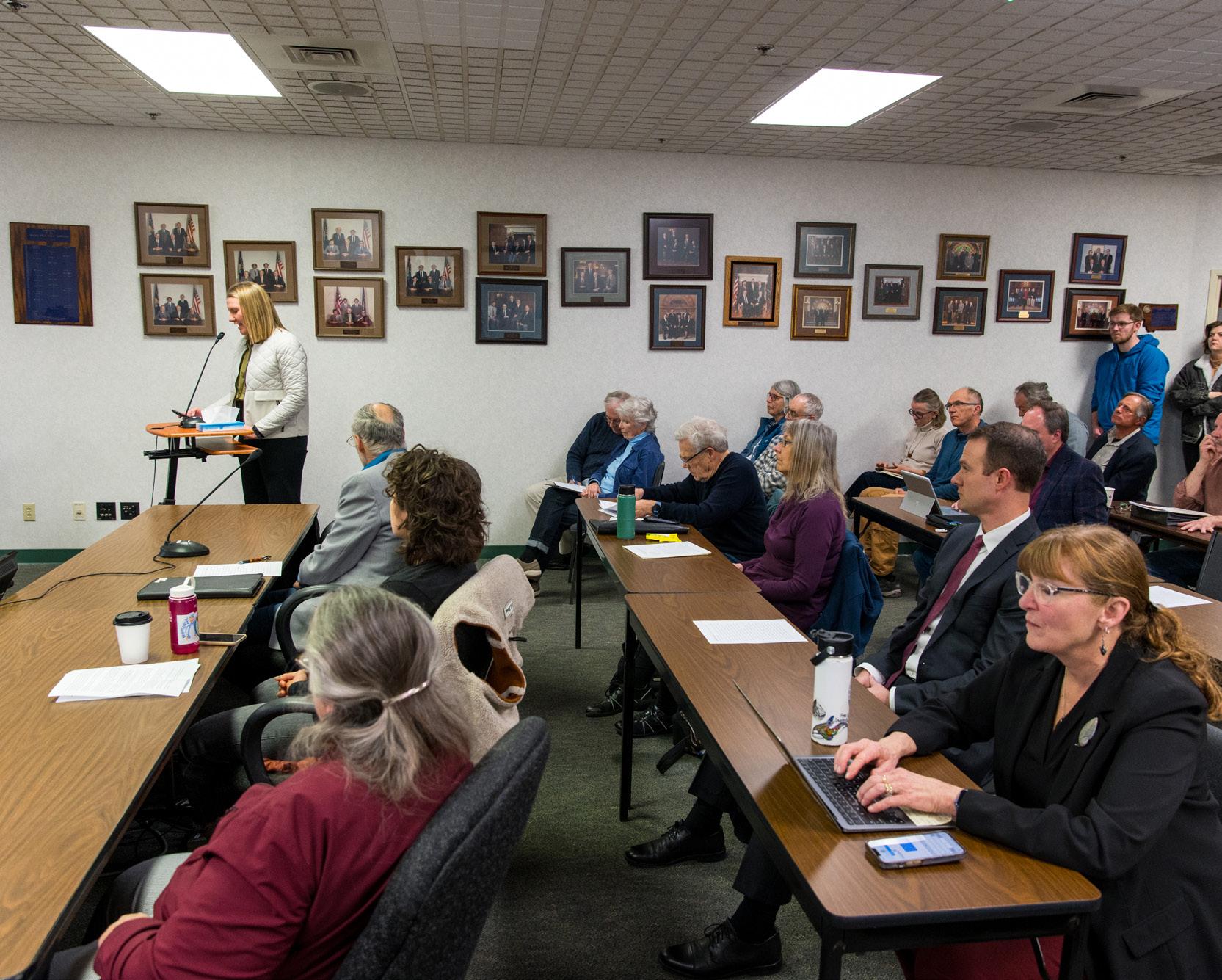
Board PrEsIdEnt: Kathy Juedeman
Board MEMBErs:
Gary Aitken
Grace Gibson-Snyder
Diana Hammer
Jim Sayer
Roger Sullivan
Beth Taylor-Wilson
Neal Ullman
Jessie Wiles
MEIC staff:
Laura Collins
Nick Fitzmaurice
Anne Hedges
Shannon James
Derf Johnson
Cari Kimball
Peyton Olson
Katy Spence
Julie Wintersteen
by Kathy Juedeman
This fall, I close out five years as MEIC board president, and my sixth year on the MEIC board. Looking at our progress, we will all benefit from the positive changes that MEIC has made to prepare for the next generation, and our grandchildren will, too.
During my time on the board, MEIC leadership shifted as long-time Executive Director Jim Jensen retired, and Cari Kimball (Executive Director) and Anne Hedges (Policy and Legislative Director) took up the mantle of Executive leadership, with Derf Johnson as Deputy Director. Jim had provided long-standing and visionary leadership. He hired brilliant and dedicated staff, who stepped up as he retired. The staff are so very effective in their individual contributions and as a collective; they really are a national treasure. This team, working with the board, has made “next generation” changes, which make MEIC stronger and more resilient.
For instance, MEIC has strengthened communications — I now see super-organized MEIC updates on Facebook and in my email inbox; I have used the Legislative Bill Tracker to contact my legislator on bills of interest (SO empowering); and have participated in MEIC learning events over Zoom. MEIC has worked to purposefully consider Diversity, Equity, Inclusion and Justice (DEIJ) in all choices. MEIC policy experts have continued to work on the hard topics: Smith River mining proposal, NorthWestern Energy’s choices, hardrock mining bad actors, air quality considerations, renewable energy, sustainable communities, and more. MEIC carefully strengthened financial investments, working with Adam McLane and board experts to ensure a clear eye on mission and vision. It is a crazy full plate.
Working on the board, I’ve had a chance to share board meeting time with national subject matter experts, environmental specialists, notable artists, and brilliant problem solvers — all in support of our shared dedication to MEIC. It is such a privilege to know some
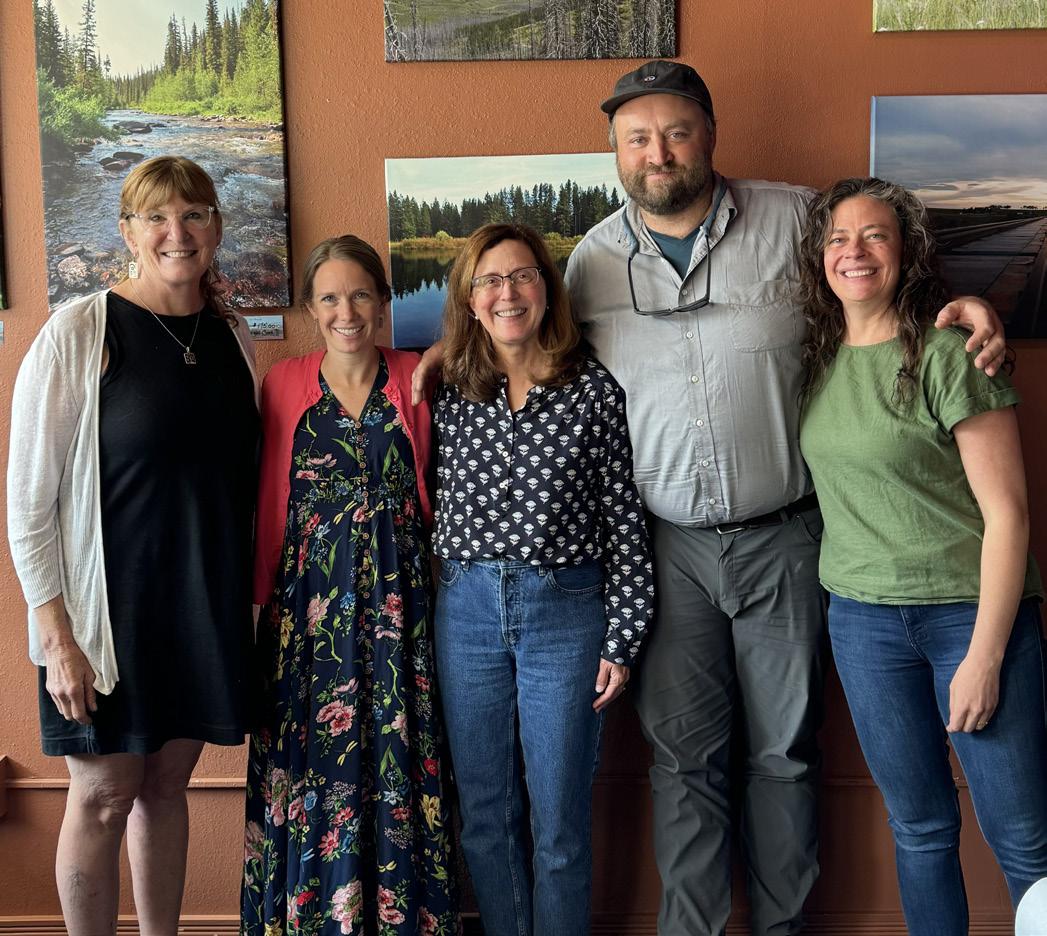
of our great Montana leaders who are strong MEIC supporters and to hear their advice on the important topics — here I will give a shout-out to Kim Wilson, Roger Sullivan, and Steve Gilbert. I hold MEIC board members in highest esteem and am so impressed by the supportive work between staff and board. In Fall 2024, Jessie Wiles will assume the board president role with a very strong board supporting her (please make sure you check out all the people running for our board on pg. 20 and vote!). She is dedicated to the mission and vision of MEIC, and her demonstrated leadership will serve MEIC well. Thank Jessie when you see her.
MEIC is described as “perhaps the most influential environmental organization in Montana” as we work for a healthier environment in our beautiful state. I always hope for a clean and healthful future, and I keep this close to my heart as I wander the hills of Montana. Keep it close to your heart too. See you soon.

Kathy Juedeman worked in the energy industry for 32 years and has been a supporter of MEIC since the 1990s, and has worked to be a strong advocate for advancing Montanans’ right to a clean and healthful environment.
by Derf Johnson
Montana’s only underground coal mine is Signal Peak's Bull Mountain Mine north of Billings near Roundup. It has been an environmental nightmare for Montana, producing enormous amounts of air pollution and entirely destroying the sparse water sources in the arid Bull Mountains. The mine is responsible for more than 14 million tons of greenhouse gases annually, ranking it in the top tier of Montana’s “super polluters.” And even more alarming, the regulators responsible for ensuring environmental compliance – namely the Montana Department of Environmental Quality and the U.S. Office of Surface Mining (OSM) – have failed to fully consider or regulate the operation.
For example, due to a case brought by MEIC and our partner organizations, the 9th Circuit Court of Appeals found in April 2022 that OSM had conducted a shoddy environmental analysis that “hid the ball” on carbon pollution and ordered OSM to conduct a more thorough environmental analysis of the expansion that actually considered and evaluated the serious climate change pollution resulting from the mine. Since that time, OSM has been conducting a review under the National Environmental Policy Act that will ostensibly include an actual analysis of the mine's climate impacts.
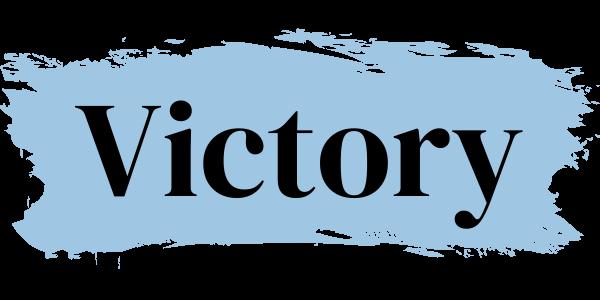
Cue Sen. Steve Daines, who obviously doesn’t have an interest in addressing the climate crisis and the incredibly alarming impacts it's having in Montana. In early June, Sen. Daines introduced a suite of legislation that, if enacted, would allow for the mine to avoid its environmental compliance responsibilities, including the environmental analysis currently being conducted by OSM. One of the bills would also privatize federal land adjacent to the Bull Mountain Mine, taking it from public ownership and placing it in the hands of a private trust in a land swap with inholdings on the Crow Reservation.
In announcing the legislation, Sen. Daines also characterized it as providing “revenue to the Crow Tribe.” Nothing could be further from the truth. Indeed, the Apsáalooké Allottees Alliance, an Indigenous organization whose members reside on the Crow Reservation, wrote a scathing editorial regarding the legislation, which you can read in full on pg. 26.
The legislation, misleadingly titled the “Crow Revenue Act (S.4444), had a hearing in the Committee on Indian Affairs in late September. It is crucial that you reach out to the committee and to Montana’s Senators Daines and Tester to let them know you oppose this cynical and dangerous legislation.

Signal Peak Energy’s Bull Mountain Mine is currently under the microscope for the serious damage it's causing to our environment – in particular our climate. Currently, the U.S. Office of Surface Mining (OSM) is conducting an environmental impact statement (EIS) under the National Environmental Policy Act (NEPA) that fully considers the climate damage caused by the mine. Notably, OSM announced that it would take until May 2026 to conduct the analysis, which is a typical time period for a NEPA review.
Recently, NEPA was also changed to require that reviews be finished within two years, unless the agency consults with the applicant on the reason for the additional time. Based on the new law and OSM’s projected date to finish the NEPA review, Signal Peak brought suit in federal district court in Washington D.C. earlier this year to force the agency to rush its environmental analysis. Thankfully, the judge found in favor of OSM in mid-August and rejected Signal Peak’s arguments.
We suspect that this is not the end of the story for Signal Peak’s legal attempts to rush or entirely avoid the environmental review, but for now we can rest easy that OSM will be given adequate time to conduct a thorough environmental analysis.
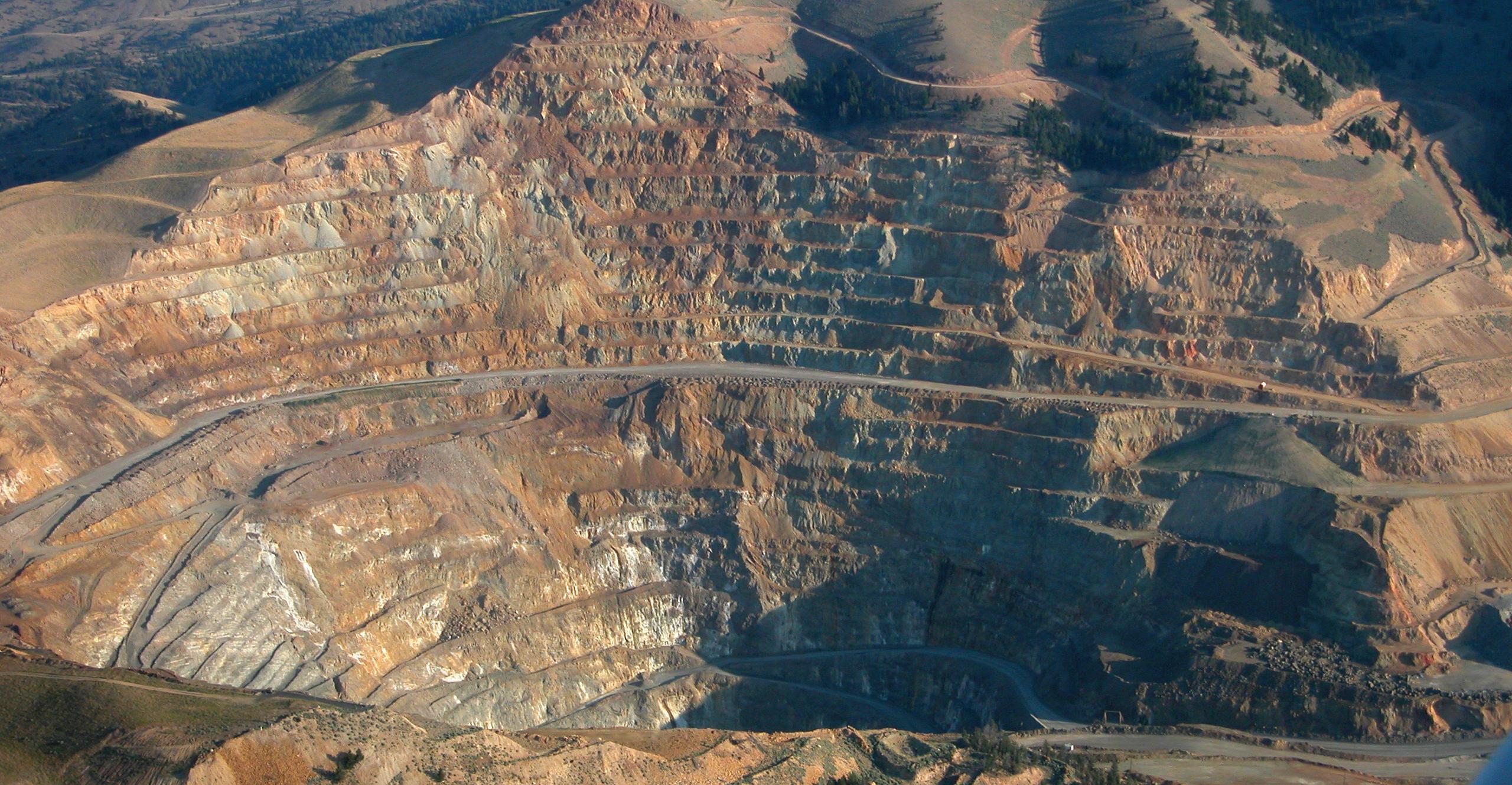
by Derf Johnson
You read that right. You may be asking: Didn’t Montana ban cyanide heap leach mining 25 years ago through a citizen initiative? Yes. Unfortunately, the initiative language also included a grandfathering clause for any currently active cyanide leaching operation with an active permit. However, the circumstances surrounding this permit transfer are dubious at best and raise serious concerns for the unique and fragile environment of the Revenue Flats area north of Ennis.
The operating permit for the Majesty Mine was originally issued in 1998 and included the use of cyanide in processing the ore. While the issuance of the permit was in advance of the cyanide ban, the mine only operated for a short period of time and then sat dormant for almost 25 years, in a state of disrepair and neglect. The Montana Department of Environmental Quality (DEQ) readily admits that “the once active gold and silver mine has not extracted or leached significant quantities of ore since 1999. The mine site has been partially reclaimed with activities including mine pit and waste rock pile recontouring, salvaged topsoil placement, and establishment of vegetation.”
For all intents and purposes, the permit should have lapsed due to the lack of any mining or ore production. What’s more, over the past decade of routine inspections conducted by the agency, DEQ noted a number of violations at the mine, including damaged fencing, cyanide barrels strewn about and punctured, and damaged liners for the impoundment. These violations persisted for over a decade, and this alone should have caused DEQ to suspend and vacate the permit. Instead, DEQ transferred the permit to an entirely new entity, relying on the original EIS from 1998 in transferring the permit. You’d be hardpressed to find another agency that would allow nearly 30-year-old paperwork to lead to this type of approval. This type of action raises serious questions. In particular, how many zombie, defunct mines are out there, with decades of non-compliance, that can simply just start up again? And is a 25+ year old environmental review really appropriate for re-permitting mines? MEIC and our partners are investigating this issue, as we have some major concerns over having another cyanide heap leach mine in our backyard.

by Anne Hedges
NorthWestern Energy is desperate for people to believe that our lights can only stay on if the utility owns more of the Colstrip plant. The Colstrip plant, a 1,500 megawatt coal-fired power plant, consists of two 40-year old units that are owned by six different companies (see graph). Each year, the plant is far and away Montana’s largest source of greenhouse gas pollution as well as many toxic air and water pollutants, including lead, arsenic, and cadmium. The problem is the plant is neither reliable nor affordable, yet NorthWestern wants to increase its share from 15% to 55%. Montanans simply can’t afford this high-risk investment in an unreliable plant.
In January 2023, NorthWestern announced its intent to double its share of the Colstrip plant by acquiring Avista Energy’s 15% share. In July 2024, months after a highly touted deal with Talen fell through, NorthWestern announced it had agreed to acquire Puget Sound Energy’s (Puget) 25% share. Both acquisitions will increase NorthWestern’s share of the plant from 222 megawatts to a whopping 814 megawatts – providing NorthWestern with far more power than its resource plans have projected needing for decades.
In 2021, Avista (which provides electricity to customers in Idaho and Washington) said the sooner
it could exit the Colstrip plant, the more economical it would be. In the past, Puget tried twice to give its share of the plant to NorthWestern but both attempts failed. Puget then struck a deal with Talen, but Talen failed to follow through. So Puget returned to NorthWestern and struck a deal in July to give NorthWestern its unwanted share. It’s like a bad penny, but instead of our monopoly utility trying to avoid it, NorthWestern is adding to its coin collection.
NorthWestern touts that it is getting more of the plant for “free,” but this is one gift horse whose mouth you should inspect closely. The Colstrip plant is extremely expensive to own and operate, which is why most utilities are moving away from coal and trying desperately to exit the plant. As part of the deal made in 2008, NorthWestern’s customers continue to pay NorthWestern $407 million for its share in the plant plus a 10% premium that the Public Service Commission allowed NorthWestern to charge customers starting in 2008 – even though NorthWestern only paid $187 million for that share of the plant a year before.
Each year, budget-busting fuel and operating costs are passed on to captive customers. In 2023, NorthWestern’s customers paid $36 million for fuel for the plant. If NorthWestern's share increases to 55%, customers will be on the hook for about $132 million in fuel costs each year. The current coal contract expires at the end of 2025, and costs are extremely likely to increase at that time.
Plant operating expenses are also significant. Non-fuel operating and maintenance costs were almost $79 million in 2023 (excluding Talen’s share). A 55% ownership share for NorthWestern means Montanans would be paying at least $52 million a year just for these non-fuel operating and maintenance costs.
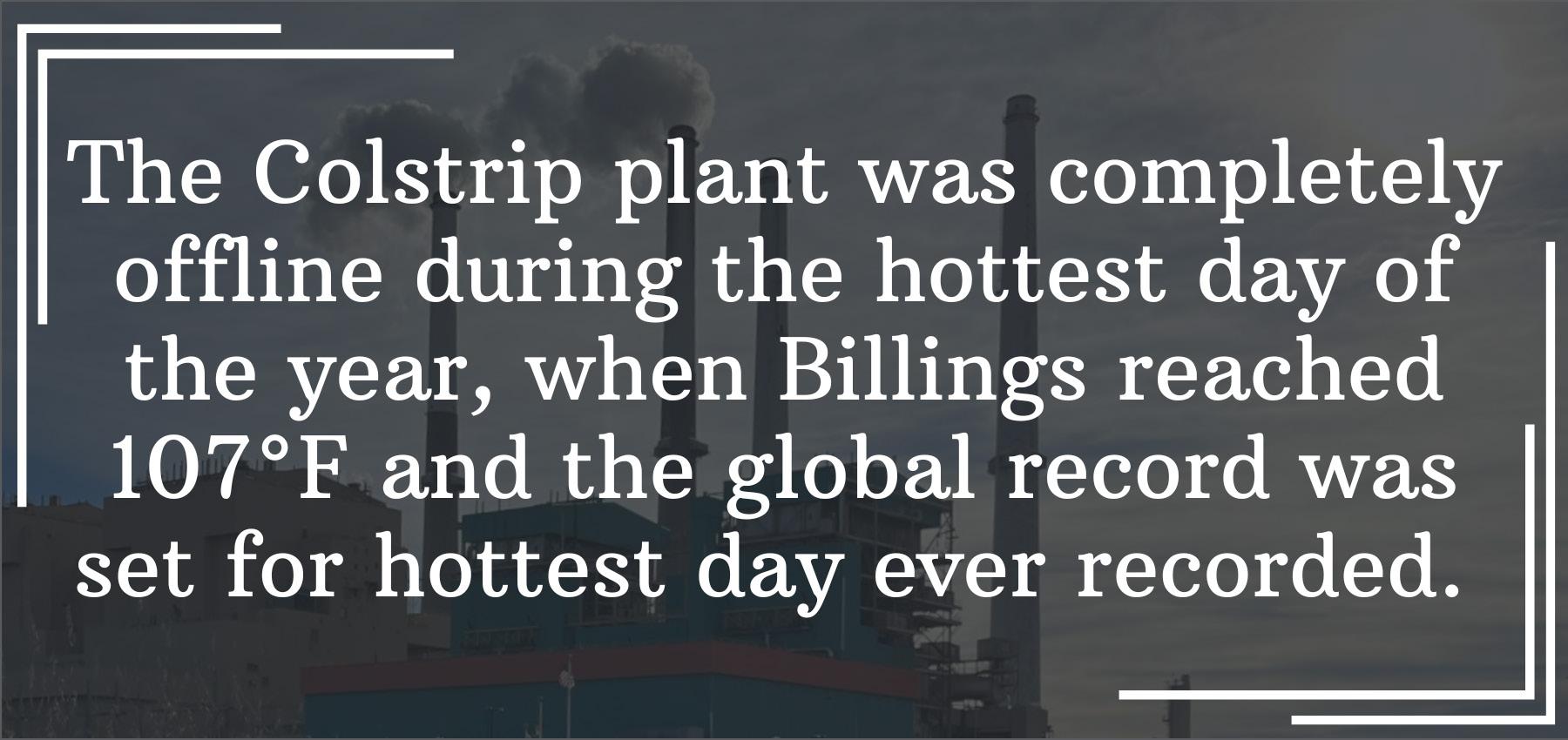
In order to continue operating until “at least 2042,” as NorthWestern representatives have expressed,
the plant will need to implement necessary — but long overdue and expensive — pollution control measures. While every similar coal plant in the nation already installed pollution controls for air toxics such as lead and arsenic, the Colstrip plant has not, resulting in it having the highest toxic emission rate of any other plant in the nation. NorthWestern estimates installing those controls now would
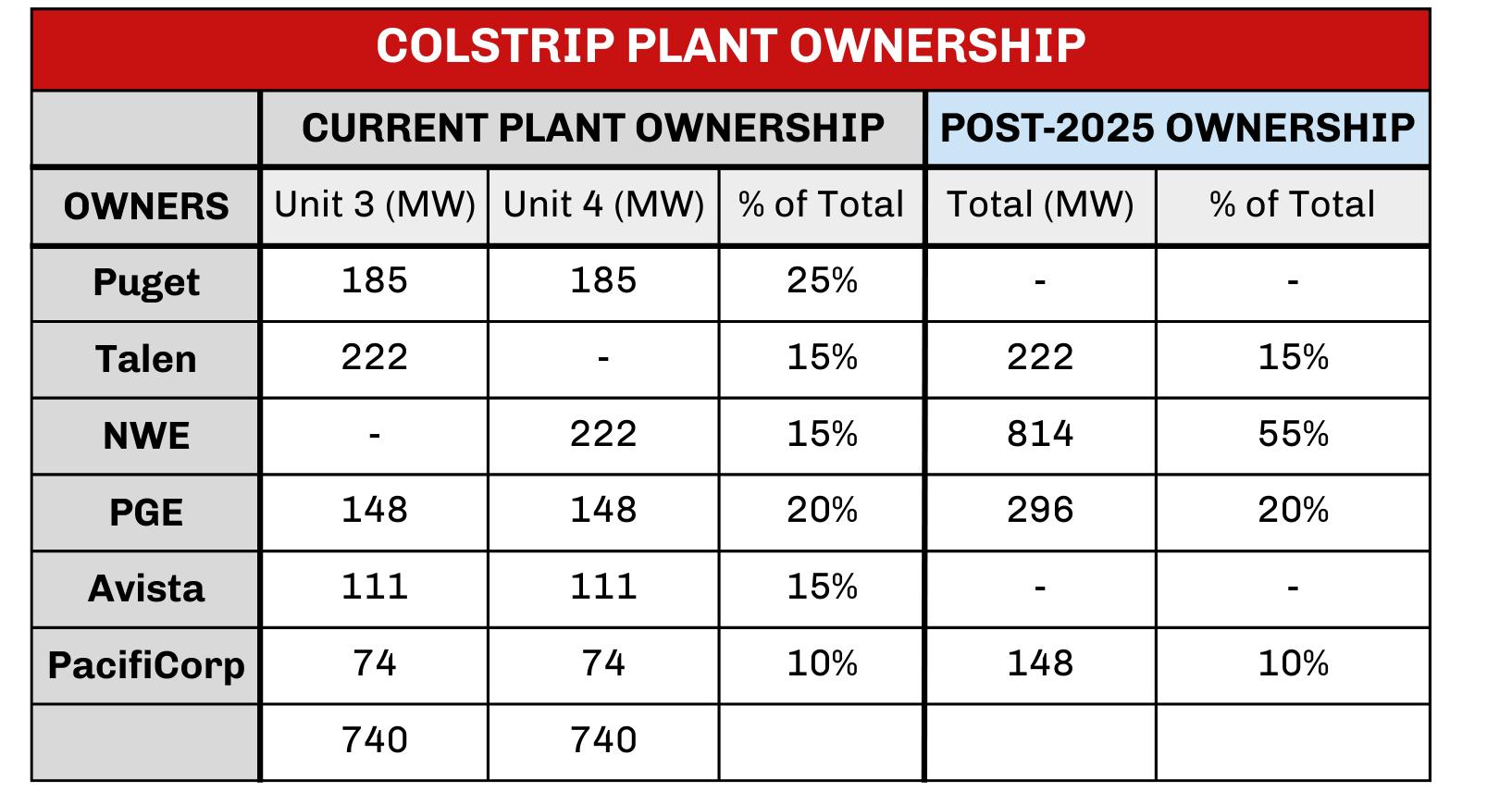
cost somewhere between $350-600 million. Carbon pollution regulations require plants to reduce emissions by 2032 or the plants must close. A secret study by the Department of Energy in 2018 found that installation of carbon controls at the Colstrip plant would be $1.3 billion for a 63% reduction in carbon dioxide and would cost about $108 million a year to operate. Due to inflation and requirements to control more than 63% of the plant’s emissions, that cost will certainly be
higher today. A 55% share of those costs would cripple the budgets of Montana families and small businesses. If NorthWestern wants to own more of the Colstrip plant, its shareholders should shoulder these costs, not hardworking Montana families who already face skyrocketing electricity bills.
There are many cheaper and less polluting ways
story continues on pg. 17
by Nick Fitzmaurice
On February 28, 2024, 40 diverse businesses and organizations asked the Montana Public Service Commission (PSC) to create a rule that would require it to consider climate change in its regulation of gas and electric utilities. The PSC determines whether and how much utilities, such as NorthWestern Energy, can charge customers for new power plants or greater shares of old coal plants.
The PSC held a public hearing on our proposed rule in April, but since that time it has been silent on whether or not it intends to create a rule. To date, it has only extended the public comment period and argued in court that it was working on the issue and the court should not force it to comply with the statutory deadline for rulemaking. Unfortunately, the court agreed with the PSC. The court accepted the PSC’s
strained argument that it had started the rulemaking process with “informal rulemaking,” so it refused to require the PSC to respond in writing to our proposed rule within the 60-day window provided by law.
This outcome is frustrating as the PSC has done nothing to move this issue forward since April. We believe the PSC has a constitutional mandate to consider climate impacts in its regulation of Montana gas and electric monopoly utilities, particularly in regard to allowing the burning of fossil fuels.
While the court ruling was disappointing, it did not say the PSC is not obligated to consider the climate impacts of its decisions. MEIC will continue to work with our partners to require the PSC to comply with Montana’s constitution and consider the economic, social, and environmental implications of climatedamaging fossil fuel activities in its regulation of Montana’s gas and electric utilities.

by Nick Fitzmaurice
NorthWestern Energy has returned to the Montana Public Service Commission (PSC) asking for permission to reach into customers’ pockets for another significant rate increase to prop up its budget-busting and heavily polluting fossil fuel investments. Unfortunately, these increases have resulted in Montana having the second highest electricity rates in the region (and fourth highest energy costs in the country), and still climbing if NorthWestern has its way.
Last fall, the PSC approved a 28% electric rate increase for NorthWestern’s residential and small business customers, and now the utility is requesting an additional 26% increase to electric base rates. NorthWestern claims that the rate increase is only 8.3%, but the utility is not telling the whole story because the fine print of its application shows the 8.3% increase is just the tip of the (rapidly melting) iceberg.
Cost recovery for the Yellowstone County Generating Station (YCGS) methane gas plant near Laurel is a major component of this requested increase. While the plant’s construction alone cost NorthWestern upwards of $320 million, previous estimates show that ratepayers may be on the hook for over $2.3 billion over its lifetime when accounting for the utility’s return on investment and property taxes, as well as operating, maintenance, and fuel costs. Financiallystrapped Montana families should not be on the hook for this bad investment.
Unpacking NorthWestern’s requested rate increase causes even more concern. While electric rates are composed of numerous line item charges, NorthWestern’s earnings from rates can be effectively divided into two components:
• A base rate for capital investments such as the construction costs for a new $320 million gas plant.
This includes the hefty return NorthWestern shareholders earn on each dollar the utility spends, such as the 10.8% return on equity NorthWestern is asking for in the YCGS gas plant.
• A fluctuating rate that is adjusted quarterly to cover variable expenses and is passed directly to customers. These variable costs include fuel costs (methane gas for a gas plant and coal for a coal plant) and power bought or sold between utilities in the region. This is called the Power Cost and Credits Adjustment Mechanism (PCCAM).
These components are usually addressed separately at the PSC, but NorthWestern has combined them in its application, obscuring the true extent of the increase. In reality, NorthWestern is requesting permission to increase the base electricity rate by a whopping 26% in this rate case, hidden behind a seemingly artificially reduced PCCAM rate.
NorthWestern’s explanation for this decrease is incomplete and somewhat misleading, asserting that the YCGS gas plant will reduce its need to purchase electricity from the market. However, close review of the application reveals that the utility anticipates nearly doubling market purchases (rather than reducing them), with these purchases offset by an unprecedented
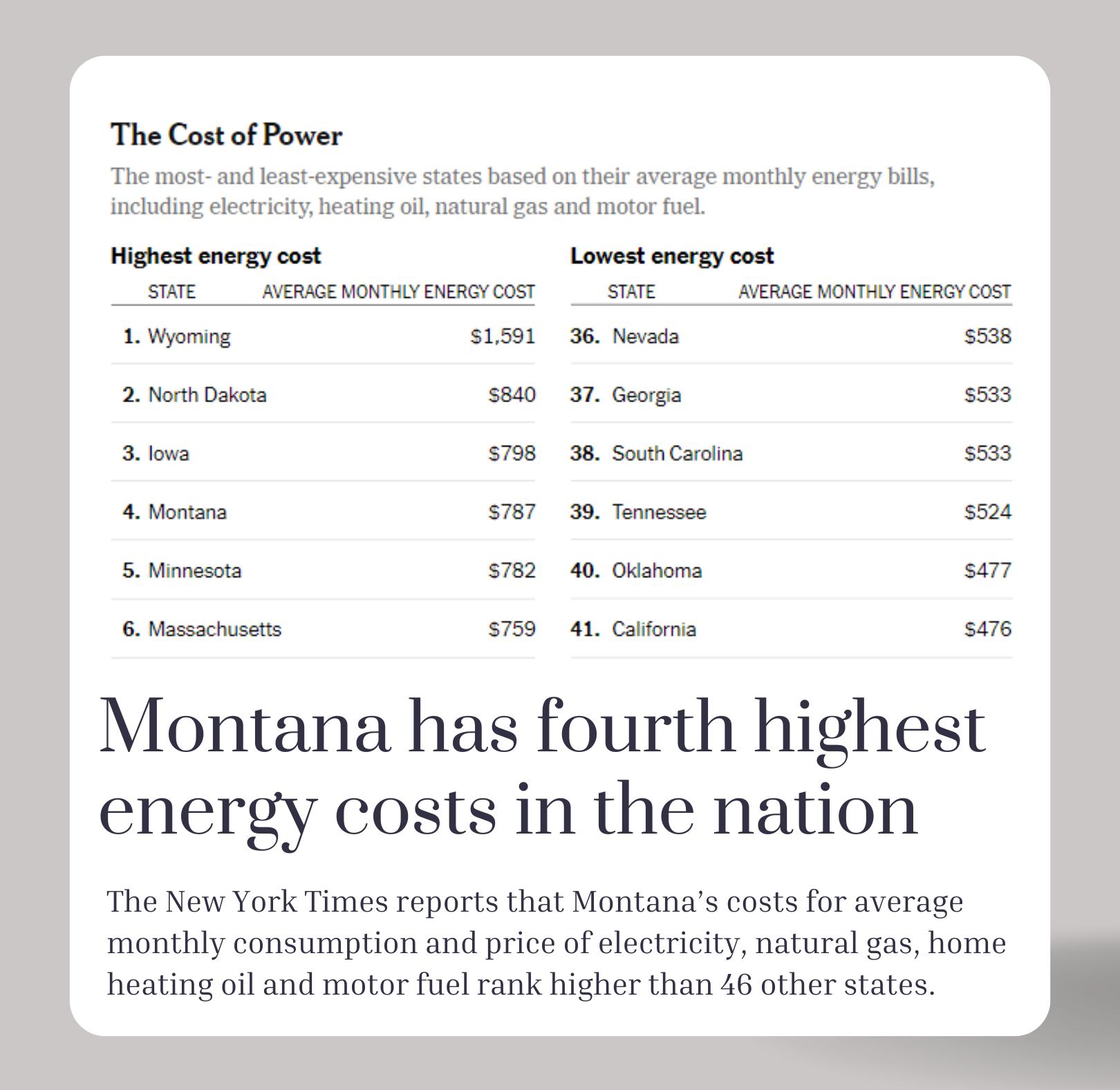
(nearly sixfold) increase in market sales. NorthWestern is showing it will have a net reduction in PCCAM costs by selling nearly six times more energy into the regional market than it does today, an unprecedented increase that the utility does not justify in its filing. It’s unclear if the outdated and constrained transmission system could even move
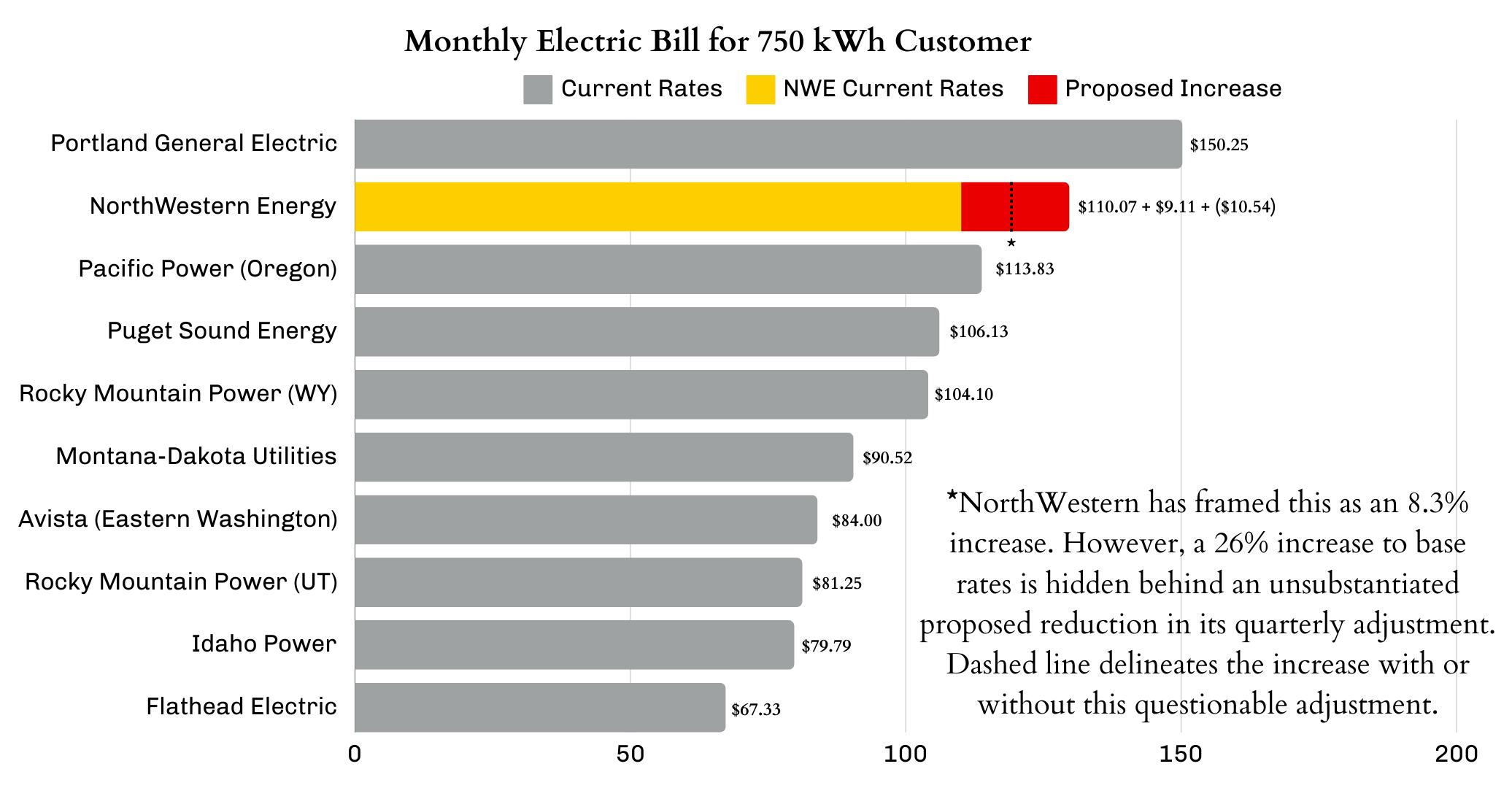
that much electricity annually. Of course, there is no penalty if NorthWestern fails to sell that much power into the market, in which case rates would skyrocket in a future quarterly PCCAM filing when customers don’t gain the fictitious benefit of a six-fold increase in NorthWestern’s market sales.
Unfortunately, NorthWestern’s greed doesn’t stop there. Having received PSC approval this July for a 33% rate increase to all gas customers, NorthWestern’s current request includes an additional 17% residential gas rate increase. That compounds to a 56% total increase in the same month! Compounded with last year’s 13% increase, that’s a 76% increase in residential gas rates that is before the PSC within a year. While the cost of expensive gas used to fuel the YCGS gas plant is technically factored into electricity rates, using more gas to fuel this plant could further strain an already volatile gas market.
NorthWestern claims it needs an increased share of the Colstrip plant because the plant provides reliable power. However, NorthWestern doesn’t bother to provide information in its application on why the Colstrip plant is necessary to ensure reliability on the power grid, other than a blind assertion that it is. This doesn't even mention that claims of the plant’s reliability are greatly exaggerated (see article on pg. 6).
Even more concerning, buried within NorthWestern’s application is the request to create a “Reliability Compliance Balancing Account” for future “compliance costs necessary to continue to operate Colstrip.” In other words, NorthWestern is asking for customers to pay for long-overdue public health and environmental safeguards, so it can keep the Colstrip plant (the country’s dirtiest coal plant) open long after its useful life. The utility provides no details on how much money it will collect from customers, what it will buy with that money, or whether there are less expensive generation alternatives. This request asks for nothing less than a blank check from the PSC, charging customers an undisclosed fee on a per kilowatt-hour basis for any and all expenses incurred to bring the antiquated plant into compliance with national pollution standards.
NorthWestern conveniently left out that these compliance costs will likely exceed $2 billion, while some have estimated that this number could even exceed $3 billion. In 2018, the U.S. Department of Energy analyzed the cost of installing carbon capture and storage (CCS) at the Colstrip Power Plant and determined that it would cost over $1.3 billion to reduce only 63% of the CO2 emissions, decreasing the plant’s energy output in the process. Operating that carbon capture technology would cost an additional $108 million annually. In addition, if the Colstrip plant owners are to be believed, they have said that installing industry-standard pollution controls for toxic air pollution could cost customers in excess of $600
story continues on pg. 17
and Healthful. It’s Your Right, Our Mission.
by Nick Fitzmaurice
In 2023, NorthWestern Energy published a wholly insufficient Integrated Resource Plan (IRP) with incomplete data and skewed modeling results supporting the utility’s expensive and environmentally damaging fossil fuel investments. Montana law requires NorthWestern to develop an IRP every three years, outlining how the utility intends to meet customer energy demands over the upcoming 20 years. Unfortunately, as the utility enters its next planning cycle, it once again neglects to engage in a transparent and rigorous process, violating statutory and administrative requirements while shirking its obligation to address the public’s concerns for reliability and affordability.
Montana’s Integrated Least-Cost Resource Planning & Acquisition Act requires “a broad-based advisory committee to review, evaluate, and make recommendations on technical, economic, and policy issues related to a utility's electricity system.” The Electric Technical Advisory Committee (ETAC) is an essential tool for guiding the IRP development process, which is why it’s concerning that NorthWestern quietly established its current ETAC at the end of 2023 with a small membership of almost exclusively government and NorthWestern-funded entities. It then proceeded to hold its first three meetings closed to the public. The utility has not satisfied the basic statutory requirement for this committee to be “broadbased” and has violated its legal obligation to make these meetings open to the public by holding these meetings in secret. In closing its technical advisory committee to the public, NorthWestern is an extreme outlier among other utilities in the region.
In the past, NorthWestern’s ETAC has consisted of a large, broad pool of unbiased, independent organizational representatives. Many had served on this committee for years or decades and are now notably excluded. They had historically gone to bat repeatedly to keep ETAC meetings open to the public and argue for affordable and reliable electric system planning. ETAC
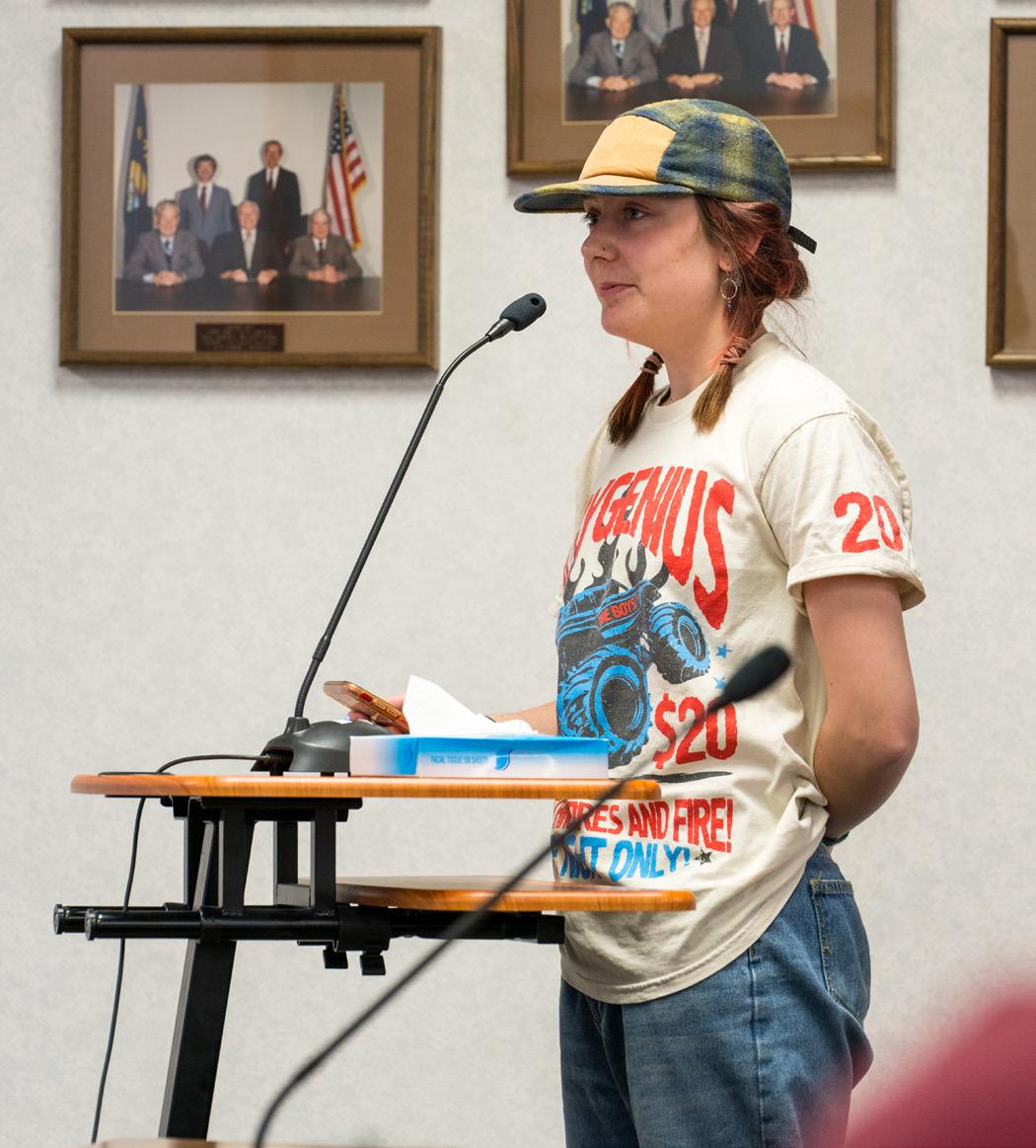
A high school student gives comment at a PSC meeting in February. If NorthWestern gets its way, the public will lose its ability to participate in the development of NorthWestern's plan.
now lacks representation from large and small-scale energy developers, low and fixed-income customer advocates, independent economists, Montana-based NGOs like MEIC, and qualified members of the public. Residential customers — NorthWestern’s only customer class showing substantial growth and arguably NorthWestern’s largest stakeholder — are not specifically represented.
When asked about ETAC at the legislative Energy and Telecommunications Interim Committee meeting in July, NorthWestern’s representative provided an ambiguous response. He neglected to mention that a new, limited ETAC committee had already met three times and that the utility had taken down its ETAC website while failing to notify the public or the legislature about the meetings, which are required by law to be open to the public. Meanwhile, NorthWestern
story continues on pg. 22

by Anne Hedges
In July, Congress passed the ADVANCE Act, a new law weakening the requirements and oversight of the Nuclear Regulatory Commission for permitting new nuclear power plants. NorthWestern Energy’s repeated commitment to replacing the Colstrip power plant with nonexistent nuclear power technology raises concerns that this streamlined permitting process could spell trouble for Montanans’ safety and utility bills. In fact, it could result in lining the pockets of NorthWestern executives and shareholders while wasting precious time in delaying the energy transition. Currently, there is a lot of unsupported hype about a new age for nuclear power. The federal government is giving away billions of taxpayer dollars to support marketing and public persuasion campaigns as well as the design and development of new nuclear technologies that are far from approval and commercialization. This is creating unrealistic expectations about nuclear’s role in the energy transition and is a dangerous distraction from deploying currently available, inexpensive technology that can meet energy needs.
Nuclear proponents started advocating for small scale modular reactors (SMRs) after largescale nuclear plants got a black eye from projects such as Georgia’s $36.8 billion Vogtle nuclear plant, (Vogtle was $20 billion over budget and 10 years overdue). Pro-nuclear interests never mention:
• There are no SMRs in commercial operation today.
• They are many years off from being approved and commercially viable.
• All radioactive waste will need to be stored onsite in perpetuity.
• Utility customers will be on the hook for budgetbusting costs.
• Nuclear plants don’t operate well in heat waves.
• Environmental justice issues raised by the re-opening of much-contested uranium mining on the Navajo Nation.
Empty promises led Congress this summer to pass the ADVANCE Act. It was a sneaky move in which nuclear proponents inserted a 93-page pro-nuclear bill into a three-page, must-pass bill on an unrelated topic. Frustratingly, Congress ignored facts and the expensive failure of other SMR projects, such as Idaho’s NuScale project that promised small Utah municipalities cheap power but only resulted in a $6 billion bill with nothing to show for it.
This new generation of nuclear technology may work someday, but it won’t be ready to address the urgent energy transition we face today. There are innumerable technologies that are cheaper, safer, and cleaner. Many are already being deployed in huge volumes that are providing people with the reliable power they deserve at an affordable price. Taxpayer money that is being funneled into dead-end nuclear projects could help develop promising technologies on larger scales, such as iron-air batteries that can store 100 hours of energy for use. Other batteries are being developed out of readily available materials such as hemp and salt. When paired with cheap solar and wind energy or installed in an electric vehicle, we rely less on burning fossil fuels and damaging mining for “critical minerals.”
To top it off, Montana has the second best wind resource in the nation and an excellent solar energy resource. Paired with energy efficiency and demand side management programs, utilities can provide affordable, reliable power now. NorthWestern shouldn’t be allowed to distract us from pushing for a clean, affordable and reliable energy future with empty promises that are at least a decade away. Robust modeling of nuclear power in NorthWestern’s next Integrated Resource Plan will show that nuclear power is not an affordable or reliable path for Montana. It’s up to the public to guarantee that this adequate modeling occurs.

by Derf Johnson
Water and pollution run downhill. This glaring observation couldn’t be more poignant when considering what’s happening with the Elk Valley coal mines in British Columbia (B.C.), which have been poisoning the waters of the Kootenay/i and Lake Koocanusa for decades. This past July, a study by the U.S. Geological Survey (USGS) found that selenium emanating from the mines in the Elk Valley can be traced over 350 miles downstream, winding its way from B.C. into Montana through Idaho, back up into Canada, and down into Washington State, where increasing concentrations suggest the pollution is even reaching the Columbia River (see graphic). This follows on the heels of a previous USGS report that found the Elk Valley mines have caused selenium, nitrate, and sulfate concentrations “among the largest documented increases in the primary literature” and possibly the worst selenium pollution documented in the world. This pollution disaster, unfortunately, has proven complex and difficult to address due to the
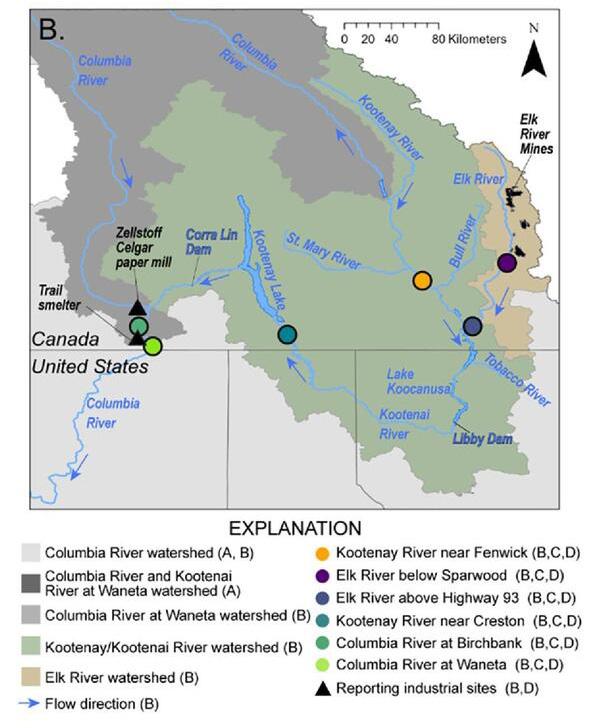
transboundary nature of the pollution and the several jurisdictions with differing regulatory authority to address the problem. Thankfully, this past March, the United States and Canada agreed to an International Joint Commission (IJC) due largely to the urging of Tribal and First Nation governments in Montana, Idaho, and British Columbia. The IJC is tasked with investigating the pollution problem and, hopefully, developing solutions to address the extensive pollution. For our part, MEIC is encouraging the government of Montana (represented by the Montana Department of Environmental Quality) to encourage a robust IJC process that results in strong, enforceable recommendations for reducing the pollution.
Specifically, MEIC has developed a set of desired outcomes from the IJC process that we will gauge the success of the final product against, which includes:
• A plan for selenium mitigation and remediation, including the consideration and potential adoption of new technology.
• Ongoing governance throughout the process which respects treaty rights and places Tribal interests at the forefront of the negotiations.
• A review of and action on bonding and financial assurances for the Elk Valley mines.
• Potential application of Montana’s water quality standard of 0.8 μg/L of selenium above the border, or a similar standard that would address Montana's elevated selenium levels and that protects the beneficial uses of water.
• A review of any new mine(s) being proposed and how those operations would exacerbate the ongoing problem. This would include the Castle proposal in the Elk Valley and others.
• A continuation and bolstering of ongoing processes, including updates to the area-based management plan and the Elk Valley Water Quality Plan.
• Consideration of compensatory mitigation/ biological offsets/land set-asides. The IJC allows for and contemplates such a possibility, and it may be appropriate in order to protect the integrity of the entire watershed.
In order to address the immense pollution problem, it’s critical that the IJC process be extensive, robust, and have strong recommendations. This is particularly important because of Glencore’s recent purchase of Teck Coal in a $12.3 billion deal. Glencore, an international commodities trading firm based in Switzerland, has the unfortunate reputation across the world of being a controversial corporation that only two years ago plead guilty in the United States to foreign bribery, corrupt payments, and market manipulation in seven countries.
Recently, Mining Watch Canada released a report entitled A Bad Deal for Canada: Controversial miner Glencore’s expansion in Canada is bad for climate and communities, which details the corporation’s extensive corruption and aggressive tactics.
The IJC process will take several years, but MEIC will watch and participate as appropriate, supporting our partners and Tribal Nations in assuring good outcomes that reduce pollution, and restore and protect the ecological integrity of the watershed.

by Laura Collins
Gov. Greg Gianforte’s Housing Task Force recently finalized a set of recommendations aimed at addressing the state’s ongoing housing crisis. The proposals seek to improve housing availability and affordability, and promote concentrating new development in urban areas.
The proposals contain some much-needed reforms to accelerate the rate of new housing development, such as revising restrictive zoning laws to allow for more diverse housing options — such as duplexes, triplexes, and accessory dwelling units (ADUs) in traditionally single-family neighborhoods — to create more opportunities for affordable housing development.
The task force also proposes incentives such as tax credits or subsidies to improve the financial feasibility for developers to build more affordable housing. The recommendations also call for expanding state and local programs that assist first-time homebuyers with financial tools to enter home ownership.
A significant aspect of the task force’s proposals is concentrating new development in existing urban areas. Dense residential development is widely recognized as the most efficient use of the land as well as the most sustainable form of growth. Urban areas are suitable for accommodating new growth and providing residents with existing infrastructure, amenities, and services. Residents’ reliance on vehicles is reduced, lowering traffic congestion and climate-harming emissions, and allowing local economies to diversify and thrive.
Sprawl and its adverse impacts are rapidly sweeping the valleys and fragmenting the landscape of western Montana, compromising working lands and natural areas. Urban densification is a key component of addressing impacts of land development, as well as affordable housing and climate change. Sprawl is inefficient and unsustainable, costly not only to the environment but to the taxpayer as well. Prioritizing urban density and limiting suburban sprawl preserves open spaces and rural communities that are essential to Montana’s identity and economy.
While the recommendations offer a comprehensive strategy for improving housing availability and affordability while fostering sustainable density, there may be resistance to changes in zoning laws or the introduction of higher-density developments, particularly in communities that are accustomed to lower-density, single-family housing. However, without these changes, Montana’s housing crisis and land consumption will only worsen. We need thoughtful, forward-looking land use planning for sustainable and equitable growth that meets the needs of Montanans without sacrificing the right to a clean and healthful environment.
MEIC will closely monitor these proposals through the 2025 Legislative Session to guarantee that any new law provides opportunities for public participation, protects the climate, wildlife habitat, and water resources, and provides housing that low and moderate income Montanans can afford in the short and long-term.


by Laura Collins
Montana's Subdivision and Platting Act (MSPA) is intended to ensure the orderly growth and development of communities, public health and safety, and the protection of our environment. However, divisions of land created under the “family transfer” exemption — that is, when transferring land to immediate family member(s) — are not subject to the same level of analysis and are exempt from the comprehensive review that is required under the MSPA.
Family transfers were originally envisioned to benefit families, primarily agricultural producers, by offering a simple method to convey equity to children. The exemption was intended to ease the process of inheritance and estate planning for families. By permitting these transactions without full review, the exemption was meant to simplify these processes for family members who wish to keep their land within their family.
In order to qualify for a family transfer exemption, an applicant must demonstrate that the transfer is not an attempt to evade the subdivision law. Unfortunately, local jurisdictions are often unable to verify the accuracy of those promises or powerless to enforce the law when it becomes obvious that an evasion has already occurred.
Despite its intended use, family transfer has increasingly become a target for fraud in Montana. This gaping loophole in land use law has been taken advantage of for decades to evade subdivision review. It
is the go-to process for developers and landowners who seek to avoid the protective measures and, in some cases, the public process that the normal development review requires. By claiming family transfer, developers can easily create unplanned and underserviced subdivisions only to be sold on the market soon after the transfer occurs.
The lack of comprehensive review under the family transfer exemption means that developments can proceed without consideration of environmental impacts, community integrity, or provisions for adequate infrastructure. Instead of these costs being borne by the developer, they are passed on to the taxpayer. Meanwhile, they avoid scrutiny and expense and contribute to exurban sprawl.
The majority of exempt divisions of land do not occur on public water and sewer systems. Instead, they rely on wells and septic systems, the accumulation of which introduces contaminants like nitrates into aquifers, endangering the drinking water of rural communities, degrading valuable water resources, and leaving senior water rights holders to face the threat of diminishing water availability. Environmental impacts extend beyond water resources. Unregulated development leads to increased soil erosion, habitat destruction, and greater vulnerability to natural disasters such as floods and wildfires. Fragmentation of Montana’s diverse ecosystems due to unchecked development threatens biodiversity and disrupts wildlife corridors, further degrading critical natural resources.
Local governments are often burdened with the
financial costs for developments that do not contribute adequately through impact and review fees required as part of subdivision review. This strains community resources for services such as police, fire, and schools, and limits the ability of local governments to address growth and development issues effectively. Ultimately, these impacts are passed on to local taxpayers.
Meanwhile, residents of small towns are caught offguard by sudden, unnotified developments, and buyers could end up with land they can't legally access or obtain water rights for. Properties may be in floodplains or on steep, unbuildable slopes. Driveways, if any, may not be wide enough for emergency vehicles, and increased traffic can negatively affect local roads — all issues that would have been addressed in the normal subdivision process but are ignored under the family transfer exemption. As development consumes land available for agriculture, hunting, and recreation, it erodes a way of life that is both irreplaceable and invaluable. Once land is developed, there is no going back.
In the face of an ever-growing number of family transfer applications, capacity-strapped municipalities have a narrow scope of analysis and timeframe to identify subdivision evasion. Guided by weak statutes and limited in their ability to identify and prevent abuses, reviewing departments are subsequently pressured to approve most requests. What’s more, the penalties for violating the exemption — totaling a whopping fine of $5,000 per infraction — are woefully inadequate to deter abuse considering that the profit of sale will outweigh any fines many times over. Besides, there is no legal recourse to undo a land division once
it has occurred.
With no shortage of incentives to exploit this loophole, developers are allowed to profit without regard for the community. It’s no wonder consultants, realtors, and their clients are taking advantage of this screaming deal. This is the reason so many family transfers are quickly sold to a third party without any consequence. These abuses are nothing less than a slap in the face to landowners who adhere to the law despite the cost and inconvenience, but do so because it is legally required and benefits their neighbors.
Despite longstanding public concerns regarding family transfer fraud, abuses continue to be untracked and under-investigated. Meanwhile, the legislature has only weakened restrictions over the years. The debate over property rights, and more recently, the availability of affordable housing have kept these loopholes enshrined in law. It seems the political will is not yet present to protect Montana from being overrun by a lack of common-sense protections for our communities and our environment.
The family transfer exemption as it stands poses far too great a deficiency in regulation and results in disorderly, unplanned development of lands across Montana. If this exemption is to exist at all, its inadequacy to prevent abuse needs to be addressed in legislation. MEIC will continue to push for the closing of this egregious loophole and the enforcement of land use policies that are centered in building sustainable communities with the input of neighbors and the oversight of local governments.

Missoula is no stranger to family transfer exemption conflicts. This area near Wye was the subject of a conflict in 2022. Image via Missoula Current.
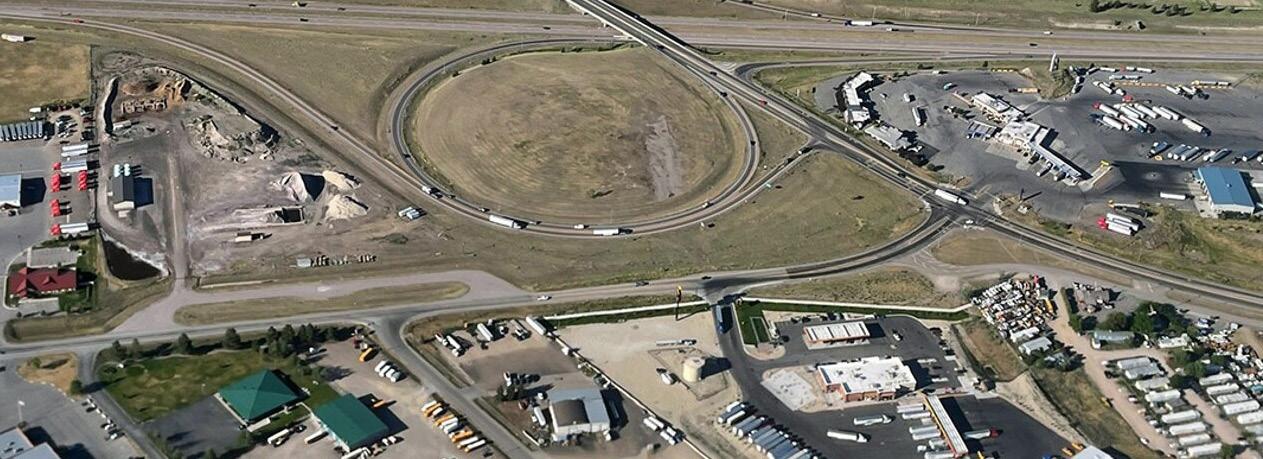
by Derf Johnson
Anumber of Montana businesses are speaking up in defense of the Smith River and supporting a mineral withdrawal of the federal lands surrounding the Smith River watershed. Their message? The current economy that surrounds the Smith River is robust and healthy, and it should not be compromised. Indeed, the recreation economy along the Smith is a vital economic contributor to the state. It’s also a source of water for agricultural producers, a favorite hunting spot for Montana sportsmen and sportswomen, and a place of respite for many Montanans at generational family cabins.
Case in point, a 2015 report by Southwick and Associates estimated that southwest Montana derives over $7 million in economic activity annually just for the angling opportunities alone on the Smith River, and a potential ripple or multiplier effect of over $11 million as businesses and individuals benefit from the increased economic activity. The Southwick report also noted that the recreation economy surrounding the Smith River generates more than $3 million in salaries and wages, and provides more than 70 jobs to hardworking Montanans. These Montanans contribute close to $1 million in state and local tax revenue, which provides additional funding for critical government services that would otherwise likely be borne by property taxes.
Unlike a high-risk temporary mining project, these economic benefits will last forever, provided that we manage the resource correctly. This means
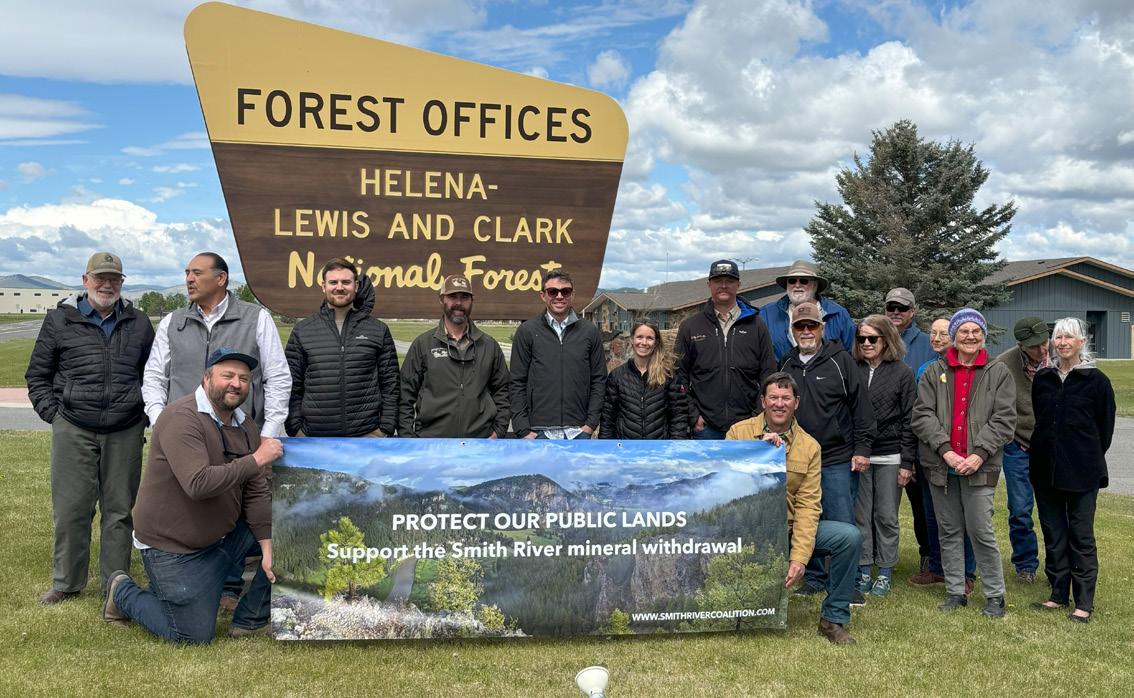
preserving the water quality, protecting the fish and wildlife, and assuring that the landscape stays wild and unfragmented. A mineral withdrawal will help us meet these goals for the Smith River watershed, which is exactly why Montana businesses are stepping up in support. A mineral withdrawal would prohibit mining on federal lands, but allow for traditional economic uses, such as grazing and recreation, to continue.
If you're a Montana business owner, or know someone who is and may support a mineral withdrawal, reach out to Derf Johnson at djohnson@meic.org
For now, we are just building a long list of businesses in support, but in the future there may be additional opportunities to speak up in favor of protecting the Smith through a mineral withdrawal of federal lands.
See current business supporters online at: www. smithrivercoalition.com/businesses


continued from pg. 7)
for NorthWestern to provide customers with power. Currently there are more than 12,400 megawatts of proposed generation in Montana, nearly all of which are renewables and more than half of which have inservice dates before 2027. NorthWestern could replace the Colstrip plant with clean energy resources if it purchased less than 5% of the output of these projects.
NorthWestern says that wind and solar aren’t reliable enough to provide power for its customers, but the reality is that the Colstrip plant is only 50% reliable when it is most needed. For example, as temperatures plummeted to record levels in early January, one of the two units at the plant had to be taken offline for "maintenance." And during the July heat wave when temperatures across the state had been over 90°F for weeks, half the Colstrip plant went offline on July 18. A few days later, the entire plant went offline. The Colstrip plant was completely offline during the hottest day of the year, when Billings reached 107°F and the
global record was set for hottest day ever recorded. NorthWestern never said why the entire plant was offline for almost a week in July. This “reliable” source of power is anything but.
Since 2023, as Puget Sound Energy planned to exit the Colstrip plant, it ramped up its purchase of Montana clean energy resources. Puget has signed long-term agreements for 665 megawatts of wind from two Montana wind farms and 40 megawatts of hydropower from Energy Keepers. In May, it announced it would add to these investments by building a 285-megawatt wind farm near Rapelje, Montana. While other utilities divest of the Colstrip plant and invest in Montana clean energy resources, NorthWestern invests in the past by acquiring more of an unreliable and expensive coal plant.
It’s time for some common sense, honesty, and transparency with a true goal of Montanans having access to reliable and affordable electricity. Montanans deserve at least that much if they have to foot the everincreasing bills.

( continued from pg. 9)
million. Every similar coal plant in the nation has already installed this technology. So, while NorthWestern seeks to nearly quadruple its ownership in the plant as the self-proclaimed only utility in the U.S. investing in more coal energy, it is asking for a blank check to pay for these upgrades – on top of the 26% increase –without considering the far less expensive alternatives to generate cleaner electricity.
NorthWestern Energy operates as a monopoly utility in Montana, with the elected Public Service Commissioners serving as the last line of defense between the utility and Montana ratepayers. Unfortunately, the PSC has bowed to NorthWestern’s requests time and time again, leaving ratepayers defenseless. NorthWestern has now built the YCGS gas plant — the most expensive type of gas plant —
and is trying to saddle customers with the expensive, unreliable, and decrepit Colstrip plant. Why? Because the utility makes a fixed rate of return on its capital investments, funded by ratepayers. The more money it spends, the more money it rakes in for its shareholders and executives’ multi-million dollar salaries. Without a PSC that demands protections for customers, it is no wonder that NorthWestern is making no further investments into wind and solar, the cheapest forms of energy available. While other states are stepping in to take advantage of Montana’s second-highest wind energy potential and fourth-highest solar energy potential in the nation, NorthWestern doubles down on the most expensive electricity-generating resources available, as reflected directly in our skyrocketing electric bills. MEIC is intervening in the rate case. Find information on our website: www.meic.org/rate-case


by Nick Fitzmaurice
Previous Down to Earth issues have explored the concept of the energy transition, numerous interrelated transformations that must be achieved simultaneously to decarbonize local and global energy systems and address the climate crisis. Past installments have addressed electrification, electricity decarbonization, and demand side management, while this article will explore transmission infrastructure expansion to ease renewable energy bottlenecks and bolster grid reliability.
Transmission is currently the greatest bottleneck to the energy transition. While developers race to build wind, solar, and energy storage resources, progress is impeded by an antiquated electric transmission system desperately needing upgrades and expansion. In fact, the amount of renewable electricity capacity waiting to connect to the U.S. electric grid is equal to about twice the total installed electric generation capacity in the U.S. at the end of 2023. According to a recent expert report, “[m]ore than 12,400 MW of new generating resources have applied to [connect to NorthWestern Energy’s transmission system]. 6,700 MW of these are under construction or in the final stages of the approval
process … and have planned in-service dates before 2027.”
Renewable energy generation in a more connected grid can reliably meet energy demand in all conditions, complementing regional weather patterns to move energy from where it is available to where it is needed. According to a recent study by the National Renewable
Energy Lab, Montana boasts the second-highest wind energy potential and fourth-highest solar energy potential in the U.S. While these abundant energy sources represent the cheapest forms of electricity, they have yet to be tapped. A further impediment is Montana’s monopoly utility which would rather pad its executives’ and shareholders’ pockets by investing in the most expensive fossil fuel infrastructure available than save customers money with clean and reliable energy; however, transmission poses a real constraint to fully developing this renewable potential. Luckily, many regional transmission planning processes are underway, including those spurred by the recent Federal Energy Regulatory Commission (FERC) Order 1920, which requires transmission operators to produce long-term transmission plans every five years. These plans cover necessary transmission system upgrades, with backstop guidance for how to allocate costs between various system users.
Decarbonizing Montana’s energy system will not be possible without building out new transmission lines and upgrading existing transmission infrastructure locally, regionally, and nationally. Navigating challenges of cost allocation, permitting, and public support for new transmission builds is essential but could take up to a decade. In the meantime, upgrading existing transmission infrastructure can produce
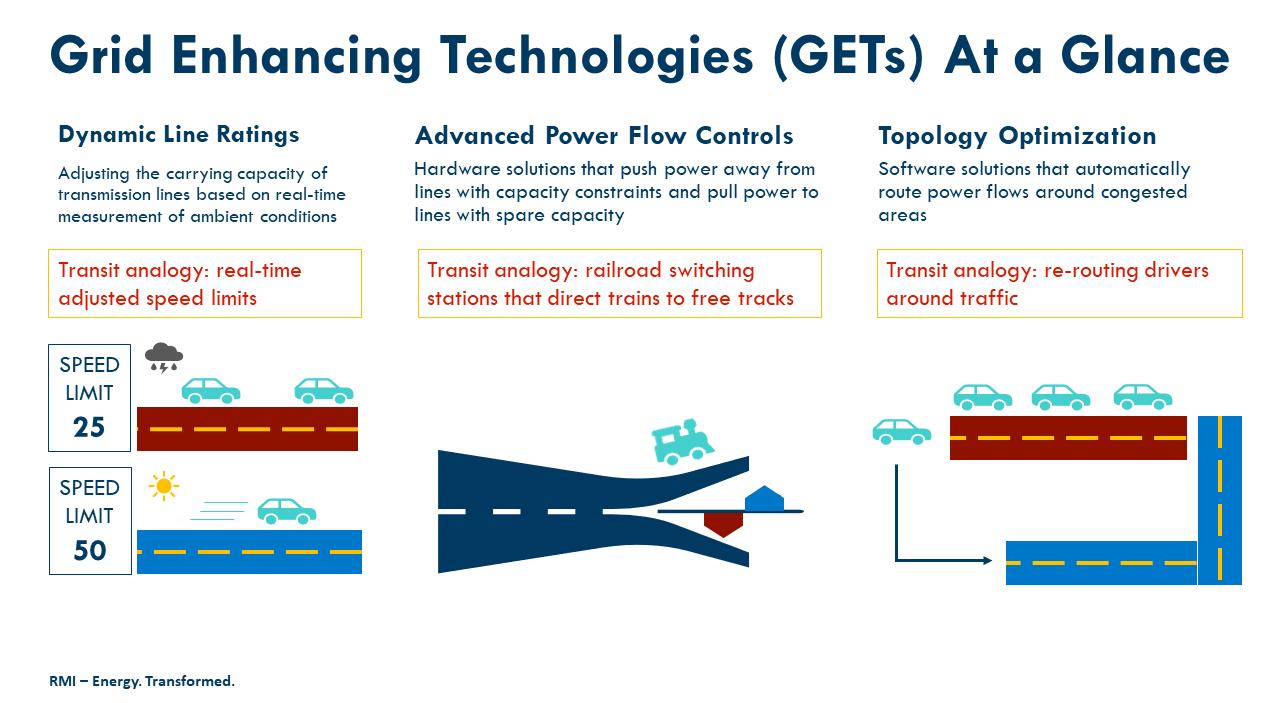

many of the same benefits at a fraction of the cost and time. For example, addressing existing transmission bottlenecks using high-performance wires (known as reconductoring) can allow more electricity to pass through a given line with limited to zero service interruption and a co-benefit of reduced wildfire risk. Furthermore, Grid Enhancing Technologies (GETs) can allow for better utilization of the entire transmission system. Grid upgrades such as reconductoring and GETs must be installed in the interim as developers navigate the obstacles to building new transmission infrastructure.
GETs are relatively cheap and easy to deploy, with the potential to increase the capacity of existing transmission lines by as much as 40%. They include digital technologies and advanced communication
devices that monitor transmission lines, transformers, and substations to use these assets more efficiently based on real-time grid conditions. These technologies have been used in Europe for years, but utilities in the U.S. are only beginning to adopt them. GETs have recently drawn attention in numerous states, and Montana has the opportunity to join this movement. The three main GETs are Dynamic Line Ratings, Advanced Power Flow Controls, and Topology Optimization.
Currently, most transmission systems use high safety factors to limit electricity flow through the system based on the most extreme weather conditions
story continues on pg. 23
CLEAN hydrogen is likely to play a role in the energy transition, but it should only be used for the most challenging decarbonization sectors – think industrial and commercial applications such as cement production, shipping, aviation, and refineries (though alternatives should be fully considered). Producing hydrogen from water using electrolysis is an incredibly energy-intensive process, placing additional load on an already overburdened energy system as we transition to meet current and future electricity demand cleanly.
Hydrogen must be truly clean, with zero associated emissions throughout the fuel’s value chain. "Green" hydrogen is the only clean form of hydrogen, produced using 100% renewable energy for the electrolysis of water. Other forms of hydrogen production that rely on fossil fuels, such as "blue" hydrogen (produced from fossil fuels where CO2 is captured and either stored or repurposed) will not be a part of a clean energy future. “Gold” hydrogen, extracted directly from naturally occurring reservoirs, should also be heavily scrutinized for associated methane and other greenhouse gases released from those reservoirs.
In October 2023, the Biden Administration announced $7 billion in awards to develop seven distinct “clean” hydrogen hubs across the US, including the Pacific Northwest and Heartland hubs. These hubs are intended to explore the use of hydrogen in different applications and using different quantities of clean hydrogen. The Pacific Northwest Hub includes a “node” in St. Regis, while the Heartland Hub may later expand into eastern Montana. The Pacific Northwest Hub intends to use green hydrogen from hydropower and other renewable energy sources, but the Heartland Hub is slated to include blue hydrogen. To truly guarantee hydrogen is 100% clean, experts have recommended that it must be electrolyzed using clean energy that is: (1) Newly built specifically for hydrogen production; (2) Delivered directly to the electrolysis facility; and (3) Matching the electrolyzer’s power consumption in real-time. While carbon-free, special consideration should also be paid to the extensive water demands of green hydrogen production.
It’s time for the annual MEIC Board of Directors election. Please vote for up to seven candidates. Only MEIC members can vote; subscribers and business corporations are not eligible to vote.
To vote by mail:
1) Complete the enclosed postage-paid card.
2) Mail the card back to MEIC in time to arrive by October 20, 2024.
To vote online:
1) Scan the adjacent QR code with your smartphone’s camera to access the online ballot.
2) Or submit votes online at tinyurl.com/MEICBoard2024.
3) Please submit online votes by October 20, 2024.
Not sure if you’re a current member? Email jwintersteen@ meic.org to check the status of your membership. Thank you for your participation.

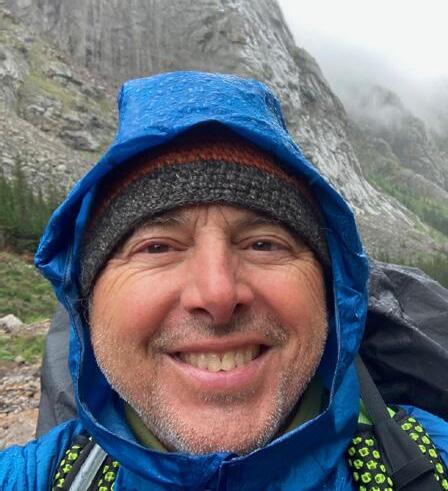
My wife and I have contributed monthly to MEIC for the last 14 years. Now that I am retired, I have the time and desire to get more involved with MEIC . I believe in service and want to put my time into trying to prevent the worst of climate change. The more I learn, the more I believe that this is possible. I am a hopeful optimist and love Vaclav Havel’s quote about hope, “Hope is not the conviction that something will
turn out well, but the certainty that something is worth doing no matter how it turns out.” My first love was plants and botany, and I graduated from Colorado State University with a Biology degree and came to Montana to work for the Forest Service. In 1983, a back injury that doctors and chiropractors were not helping me with led me to acupuncture. It helped me and caught my interest, and I resigned from the Forest Service and went to Acupuncture School. It turned out to be a good fit for me as I am a bit of a rebel and independent thinker. I have spent the last 35 years as an acupuncturist, 33 of which have been in Kalispell. Part of my practice was environmental illness and anxiety, neither of which are well-addressed by western medicine. It is my conviction that the best way I can serve my past patients and their children is to work to take care of our environment and our climate. I look forward to getting more involved by working on the MEIC board.

(she/her), Helena
I am a mom of two young kids and an attorney living in Helena. I have an undergraduate degree from the University of Montana in Recreational Management of public lands. I also have a law degree from Lewis and Clark Law School with a certificate in Environmental and Natural Resources Law. For the last 10 years, I have been working in areas of public land law and Indian law for the federal Department of Interior Solicitor’s Office, for the State of Montana DNRC, and now in private practice. As
a mom, I am passionate about giving our kids the chance to thrive in a clean and healthful environment and supporting our Montana families as we work to address the challenges and inequities brought on by climate change. I am thrilled to have the opportunity to work with the amazing staff and board of MEIC to raise awareness of the most effective environmental advocacy organization in Montana doing the hard work to advocate on behalf of concerned citizens every day.

Molina (she/her), Bozeman
No living thing can thrive without a healthy environment. Yet, profiteering corporations are allowed to frack our land, poison our water, and pollute our air all the time. That is why MEIC ’s work is so vital. As a leader in Gallatin Valley Sunrise, a youth organization fighting for a socially just, fossil fuel-free Montana, I testified to support the 2024 PSC Rulemaking Petition. Alongside the dozens of other organizations MEIC organized for this petition, I urged the Public Service Commission to take action on climate
change in Montana for the sake of young people everywhere. On the board, I hope to contribute my voice as a young, first generation low-income college graduate. My experience in community organizing, stint in nonprofit development, and background studying literature give me a community-grounded, collaborative perspective, and strong ability to read, think, and make deep connections. I want to join the MEIC board to protect the rivers I play in, the air I breathe, and the land I love.
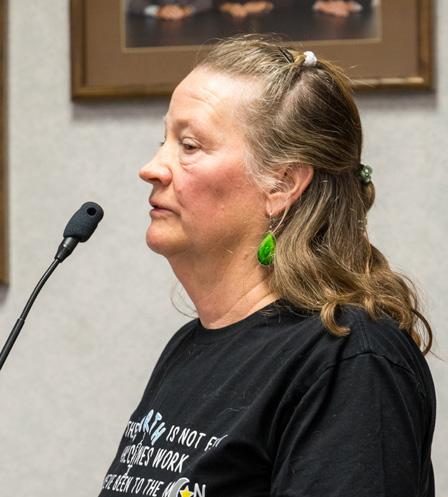
(she/her), Missoula
I grew up in Missoula. Post high-school, I took a break from studies at the University of Montana, and took a “summer job” in Jackson Hole, Wyoming, moving away from Montana just as our fair state was drafting and adopting our extraordinarily prescient, forward-facing Montana Constitution. Montanans became constitutionally assured the “fundamental right to a clean and healthful environment.” When I left, Missoula had some of the worst temperature-induced winter “inversion” air pollution in the
country. But thanks to activists like the Gals Against Smog and Pollution (GASP), who numbered my mother as a member, Missoulians forced the then Hoerner-Waldorf paper mill plant to start cleaning up its corporate act. Missoula’s air became far cleaner and healthier thanks to environmental mitigation and citizen activism. Environmental activism and stewardship is in my family DNA, and I’m excited and honored to have the opportunity to work with our state’s premier environmental watch-dog.

I am an avid explorer of public lands, waters, and spend as much time outside as possible. I studied environmental science at Macalester College, served as an Agroforestry volunteer in the Peace Corps in West Africa, and worked for WWF/IUCN. I have an MPH (Johns Hopkins) and an MS in Biomimicry (ASU). I worked for the U.S. EPA for nearly 30 years on projects such as the Milltown Dam Removal, Clark Fork River Restoration, and in partnership with Tribal Nations across Montana and beyond to address environmental challenges. Through my volunteer and consulting work, I am committed to creating more resilient communities in a changing climate. MEIC ’s work is essential to protect our constitutional right to a “clean and healthful” environment – where we live, work, and play! I have been on the MEIC board since 2020 and would be honored to continue to serve.

Kalispell
MEIC is the most effective environmental advocacy organization in Montana! It has been a great honor to work with MEIC in our continuing quest to vindicate the right of this and future generations of Montanans to a clean and healthful environment. In this effort, I have both served on the MEIC board and successfully advocated on behalf of MEIC on a number of occasions, including against oil and gas exploration adjacent to Glacier National Park, against the Highwood Coal-fired Generation Station near
Great Falls, opposing expansion of the Rosebud Mine, and helping to achieve closure of Colstrip Generating Units 1 and 2. I also do a substantial amount of collaborative work with others working to achieve climate justice, including serving as trial and appellate counsel for the youth plaintiffs in Held v. State of Montana. If selected to serve again, I would hope to contribute to MEIC through participating in the thoughtful analysis of requests for MEIC ’s involvement in new matters, in the effective management of litigation, and in envisioning a sustainable future for MEIC — and future generations of Montanans!
( continued from pg. 10)
is working behind the scenes to eliminate ETAC from statute altogether in the upcoming legislative session, further jeopardizing transparency and public trust in the IRP process. MEIC will not stand for this.
MEIC brought these concerns to the Public Service Commission (PSC) in July, which promptly responded with a letter to NorthWestern reaffirming MEIC’s concerns and requesting the utility explain its current ETAC process and reconcile its actions with Montana law and Commission rules. NorthWestern’s response was defensive and unapologetic, though the utility brought its ETAC webpage back online and
asserted that its next ETAC meeting would be open to the public – though the public could only participate remotely with no opportunity to comment. While ETAC membership remains far from broad-based, MEIC advocacy at the PSC and legislature are ongoing to keep these meetings public and guarantee more transparency and broad-based representation in these meetings. Unbiased experts must have access to ETAC to ensure that the utility’s next 20-year plan employs sound modeling to fairly represent Montana’s clean, affordable, and reliable energy potential.

( continued from pg. 18)
the infrastructure might encounter seasonally or throughout its operating life. This avoids overloading the system with too much electricity in weather extremes where overheating may damage infrastructure or ignite wildfires from super-heated sagging lines. However, higher capacities can be achieved in most weather conditions if lines are monitored in real-time. Technology such as LiDAR imaging from transmission towers, in-line sensors, or data from nearby weather stations can monitor real-time line temperatures and forecast future temperatures so operators can maximize power flow throughout the system.
Today’s electricity grid is more rudimentary than
at Kevin-Sunburst Oil Field with Well Done Foundation
many would think, with grid power flow controlled by manually flipping switches at stations and substations throughout the system. This control can be achieved remotely and more strategically by installing digital control devices at substations between generators and electric loads so operators can optimize power flow, ease overburdened circuits, and safely move more power when possible.
By incorporating a digitalized system-wide electricity grid model, specialized software can monitor and balance electricity flow throughout the system. Rather than a fallible human operator, this software mathematically determines and remotely programs optimal grid configurations in real time.

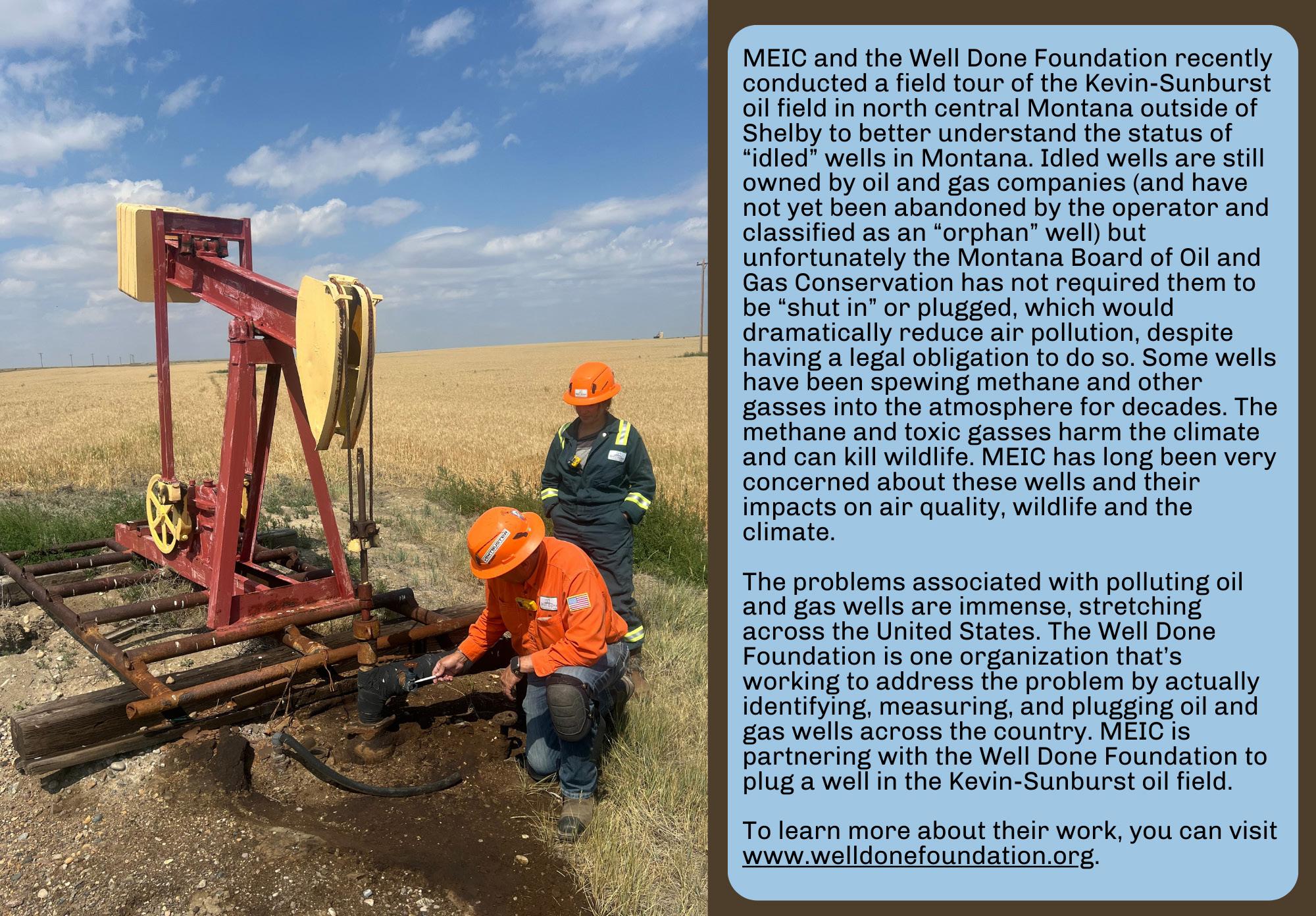

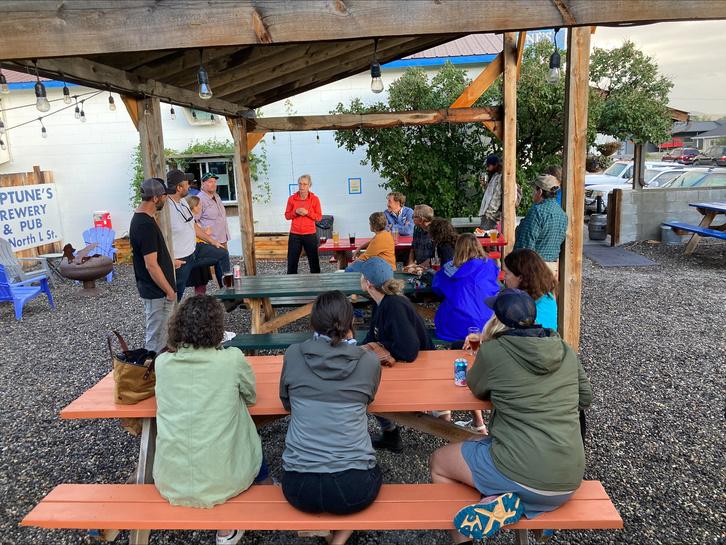
Neptune’ s Brewing in Livingston featured MT Watershed Partners.
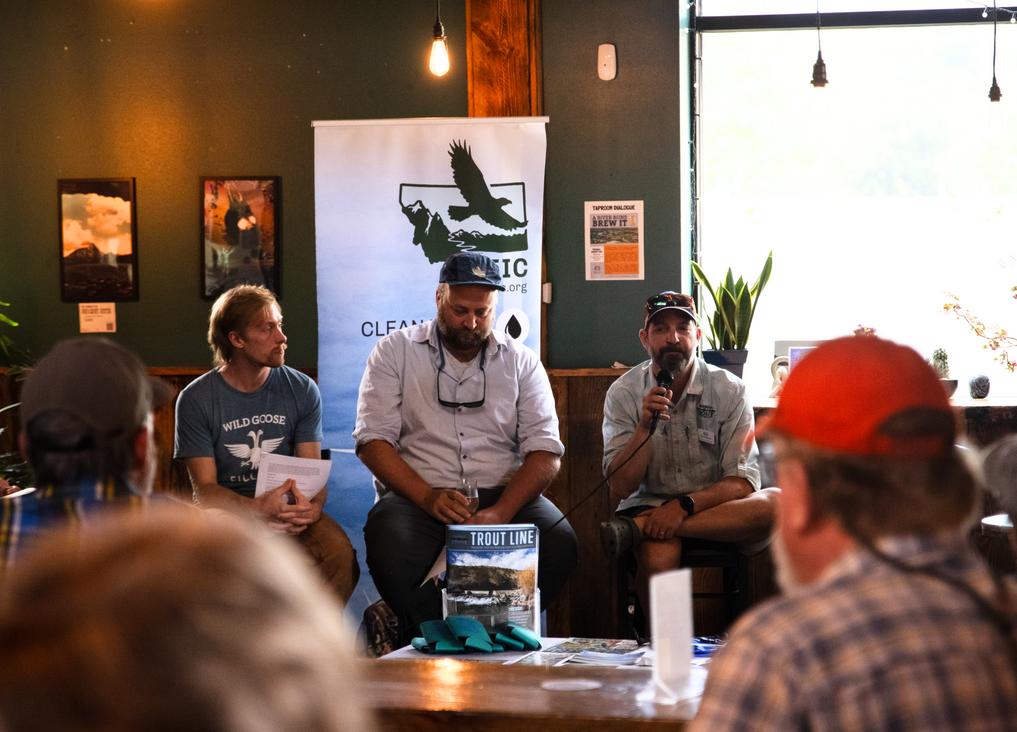
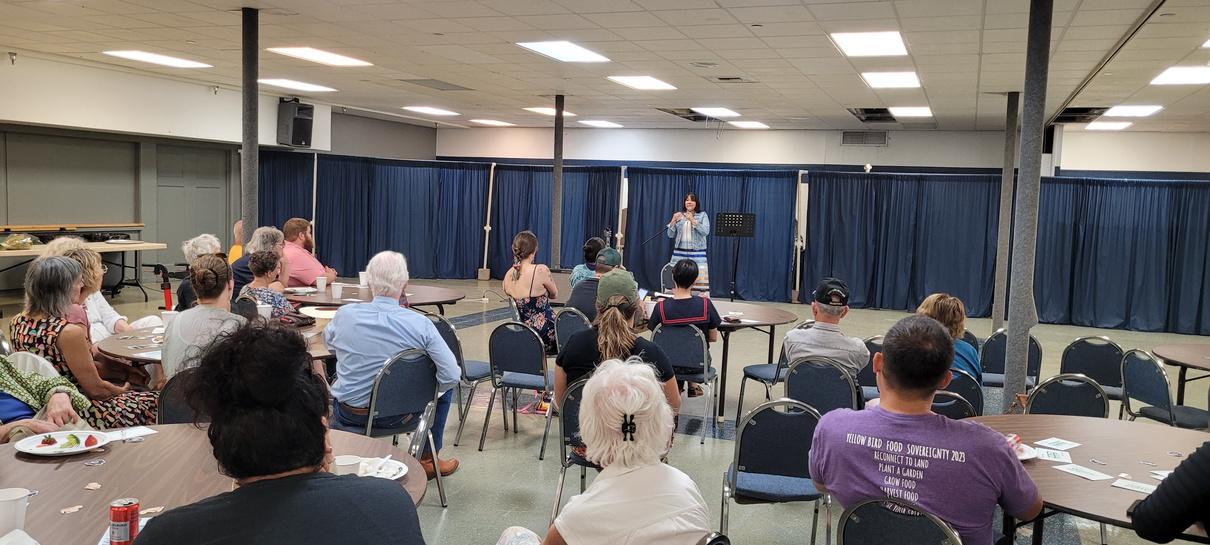
MT Trout Unlimited joined us at Imagine Nation Brewing in Missoula.
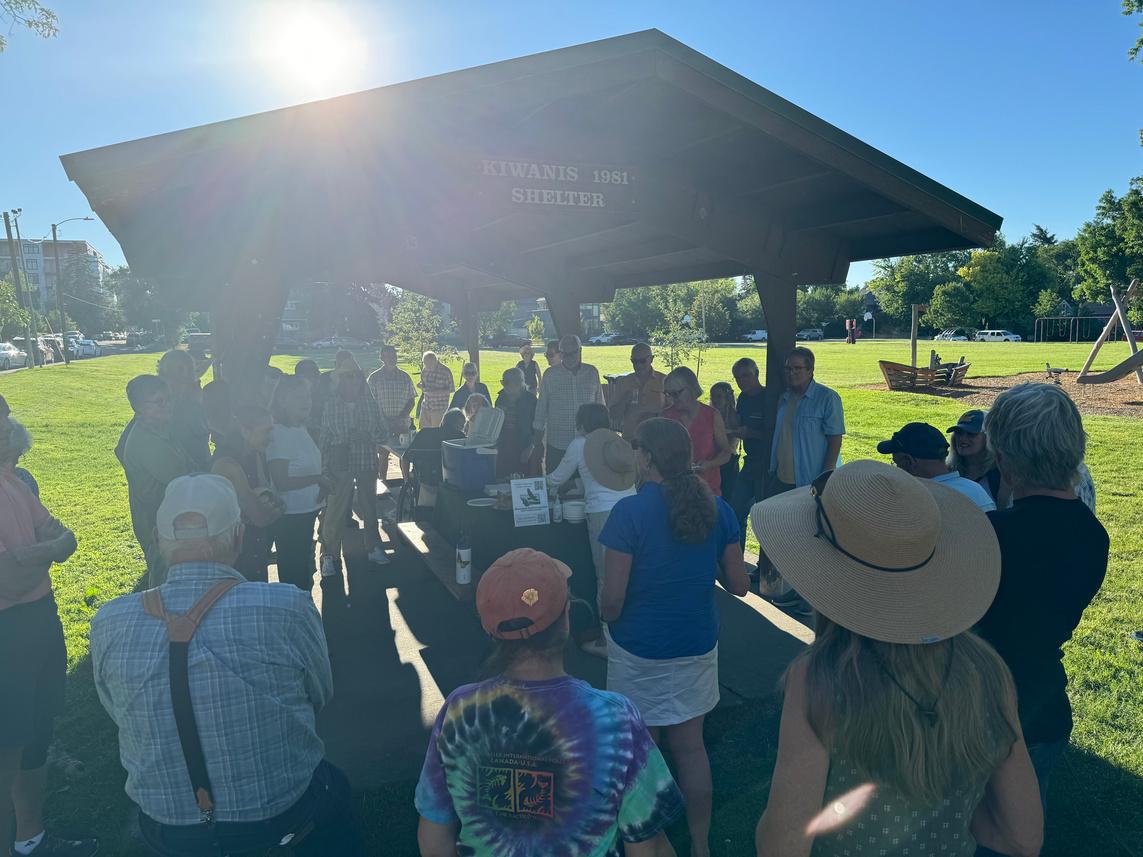
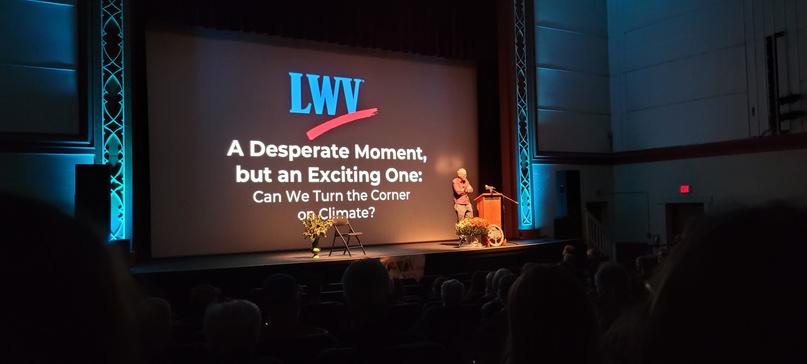
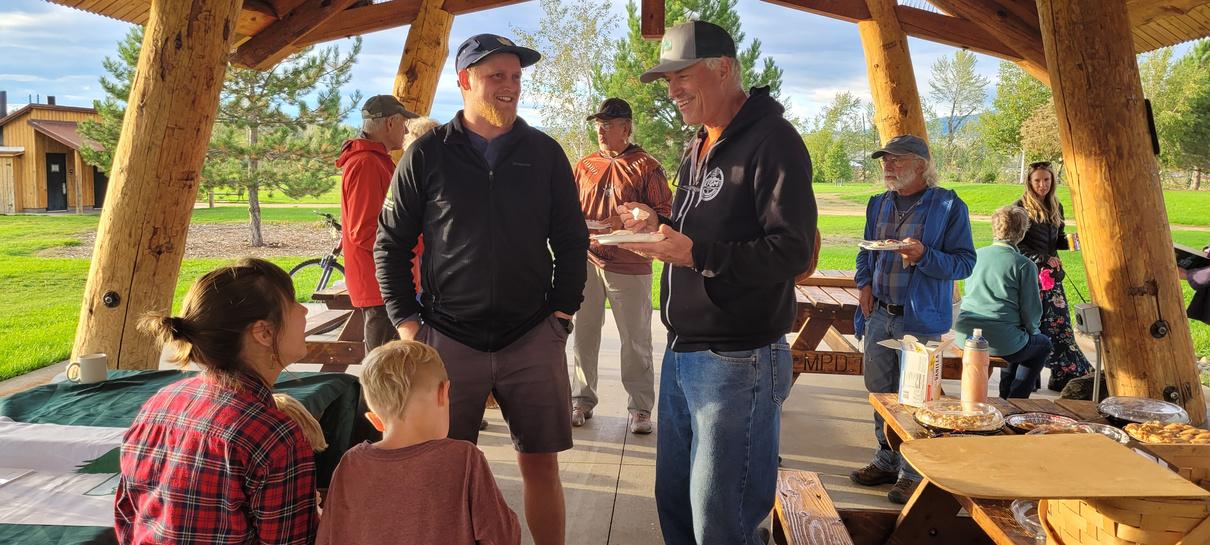
Great times in Bozeman and Helena with our members this summer!
Missoula rounded out our summer socials with pie and ice cream.

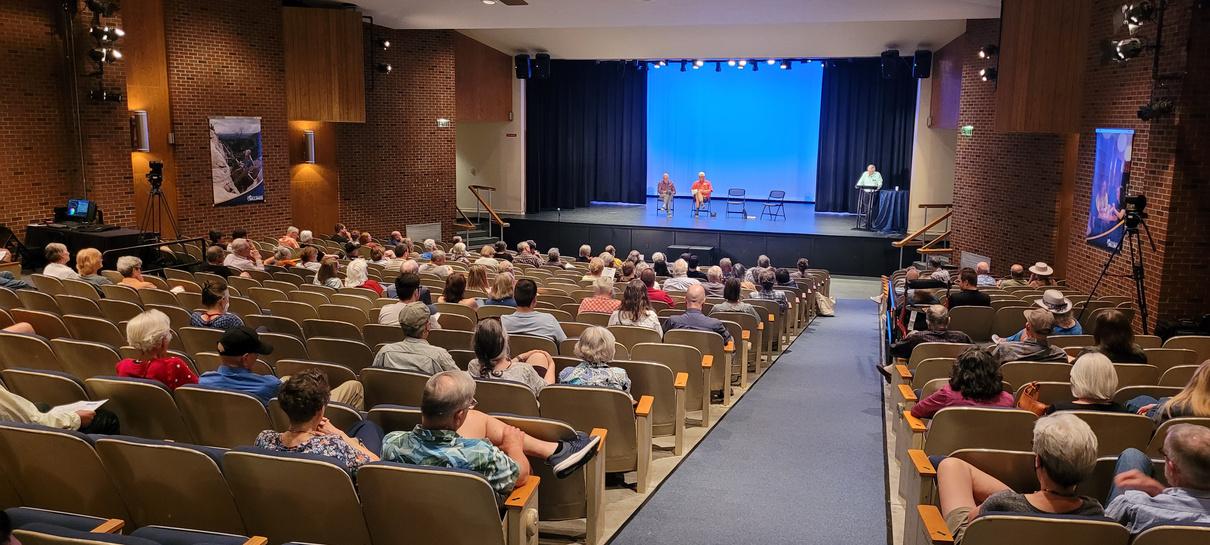
Krystal Two Bulls of Honor the Earth kicked the week off with Forward Montana and Western Native Voice.
Bill McKibben joined the week as the keynote speaker.

MREA and Renewable Northwest joined MEIC for a panel about transmission.



Anne and Katy hung out with hundreds of climate activists.



MEIC is fortunate to partner with the Apsáalooké Allottees Alliance (AAA), an Indigenous, nonprofit advocacy organization dedicated to helping and educating individual Apsáalooké trust allotment landowners about land and water rights issues. In recent months, AAA has been raising awareness and pushing back against proposed federal legislation that would pass coal mine pollution to the local land and water while passing the mining profits along to a multinational corporation and a private family trust.
The history of Montana is rife with examples of powerful political or corporate interests coming in, making agreements to work with Indigenous communities respectfully, and then breaking those promises with devastating consequences for Native people and the land, water, and wildlife they steward. For that reason, it is perhaps unsurprising — though still infuriating — to see this storyline of injustice unfolding again in the form of a land and mineral swap that Sen. Steve Daines is attempting to push through Congress. We share the following opinion editorial from Mike Hill and Alee Bird Hat of the AAA with immense appreciation and gratitude for their leadership, partnership, and their wise stewardship of this beautiful and vibrant place. - Anne Hedges, MEIC
The Apsáalooké Allottees Alliance is an Indigenous organization whose members reside on the Crow Reservation. We are no strangers to those who seek to take advantage of our lands and waters, offering much and delivering nothing. We fear that the “Crow Revenue Act” (S.4444 from Senator Steve Daines) is more of the same.
Some politicians are calling S.4444 a “commonsense solution” and claim it will bring new revenue to our people. This is not the case. Reading the bill reveals that the federal government will give the Hope Family 4,530 acres of mineral interests and 940 acres in surface interests next to an operating and profitable coal mine in the Bull Mountains. In exchange, the Hope Family will convey to the Tribe its 4,660 acres of mineral interests under productive ag land on the Crow Reservation with little likelihood of future mines nearby. If the Crow Nation were to pursue development of the Bighorn County tracts, we would have to enter a revenue agreement “if those mineral interests are developed at a later date.”
Senator Daines’ Fact Sheet on S.4444 misstates the provisions of the bill. It says the bill “requires the Hope
Family and the Crow Tribe to enter into a revenue sharing agreement[s] for the development of any mineral interests in the Bull Mountain Tracts.” Instead, the bill gives the public minerals and surface rights, referred to as the Bull Mountains Tracts to the Hope Family. The bill gives the Crow the minerals on the Hope Family Tracts which are not likely to be mined for coal.
Furthermore, rather than requiring the Hope Family to share revenue with the Crow Tribe from the Bull Mountain Tracts, it requires the Tribe to share revenue from the Hope Family Tracts (in the unlikely event they are ever mined) with the Hope Family Trust, despite the fact that 100% of the mineral rights beneath the Hope Family Tracts are to be held in trust by the United States for the Crow Tribe. Thus, the Hope Family Trust would receive 100% of the royalties from the Bull Mountain Tracts, as well as an unspecified share of royalties from the 100% tribally owned Hope Family Tracts.
The bill’s, “Revenue Sharing Agreement,” also creates a burden on the mineral rights the Tribe would receive in favor of the Hope Family Trust. The Tribe would be required to negotiate with the Hope Family Trust to gratuitously give it a share of the coal royalties from those lands. There is no justification for this, and it can only be characterized as outrageous.
The Bull Mountain Tracts are currently leased by the United States for coal mining, with royalties payable to the United States. This legislation would give valuable
mineral and surface rights and coal royalties otherwise payable to the United States to the Hope Family Trust. There is no justification for gratuitously enriching the Hope Family Trust at the expense of the United States, in return for the Tribe receiving mineral rights of little value.
Our people have been promised more than is delivered time and time again. The Crow do not need another beautifully wrapped birthday present, only to open it and find it is empty inside. The Crow People have great need for revenue, infrastructure, and investments on Tribal and Allotted land. This bill provides none of these things. According to our Crow Constitution, our chairman cannot act on his own. He must take this major decision to the Crow General Council where it would normally be subject to a referendum vote.
We have worked hard to protect our culture, our land, our water, and our people. S.4444 is an injustice reminiscent of so many in our history and Native history in this country. It would be yet another grave injustice to allow this bill to pass. Please vote no on this bill.
Mike Hill and Alee Bird Hat are the President and Vice-President of the Apsáalooké Allottees Alliance (AAA). AAA is an Indigenous, non-profit advocacy organization dedicated to helping and educating individual Apsáalooké trust allotment landowners, including all aspects of allotted land and water rights issues.
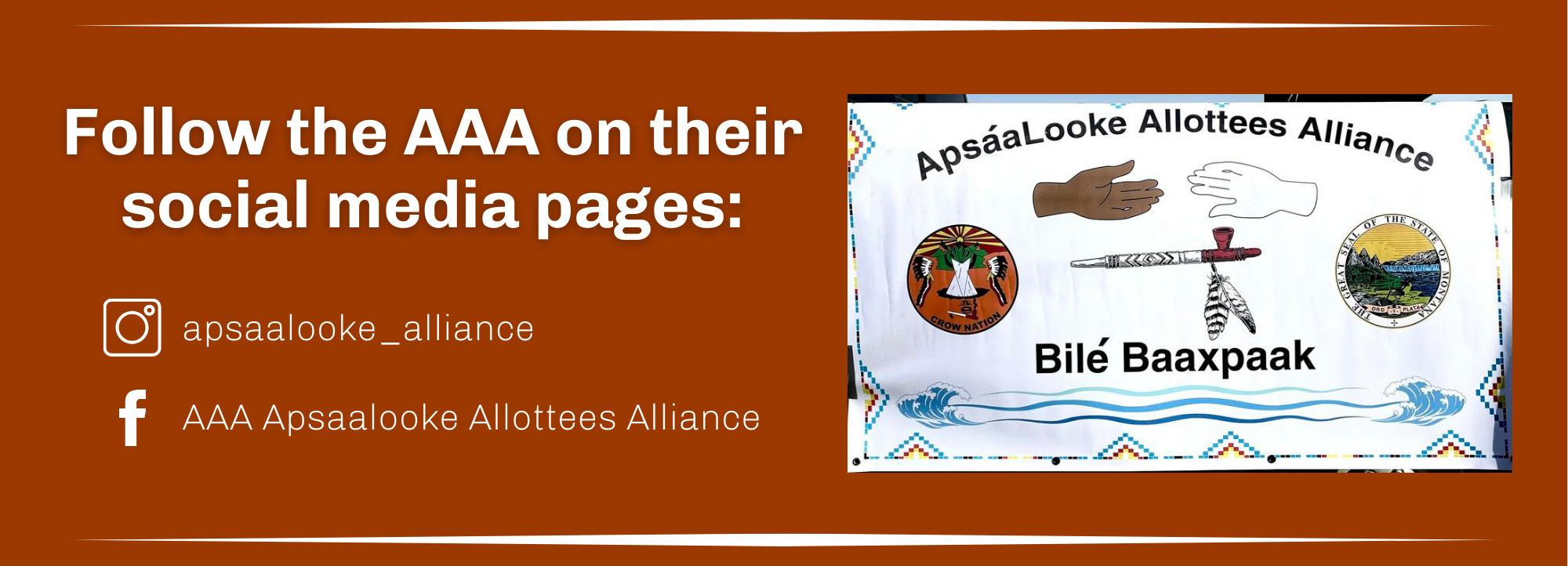
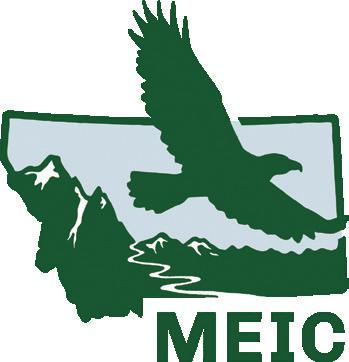
P.O. Box 1184 Helena, MT 59624
